- Electrification for commercial vehicles
- Fantastic touch screen
- Solid driving nature
- Not cheap at all
- No standard dual sliding doors
- No towing ability
EVs are slowly but surely gaining traction on the Australian new car market, with sales of passenger BEV vehicles going from strength to strength. However, the complexities of scaling EV technology for commercial vehicles, amongst other barriers, has led to a stark absence of battery powered Utes or Vans from Australia’s roads. However, two electrified, large commercial vans, the LDV eDeliver 9 and the 2023 Ford E-Transit have come to the Aussie market within six-months of each other – we wanted to find out if EV vans are now a viable option for delivery and trades-people?
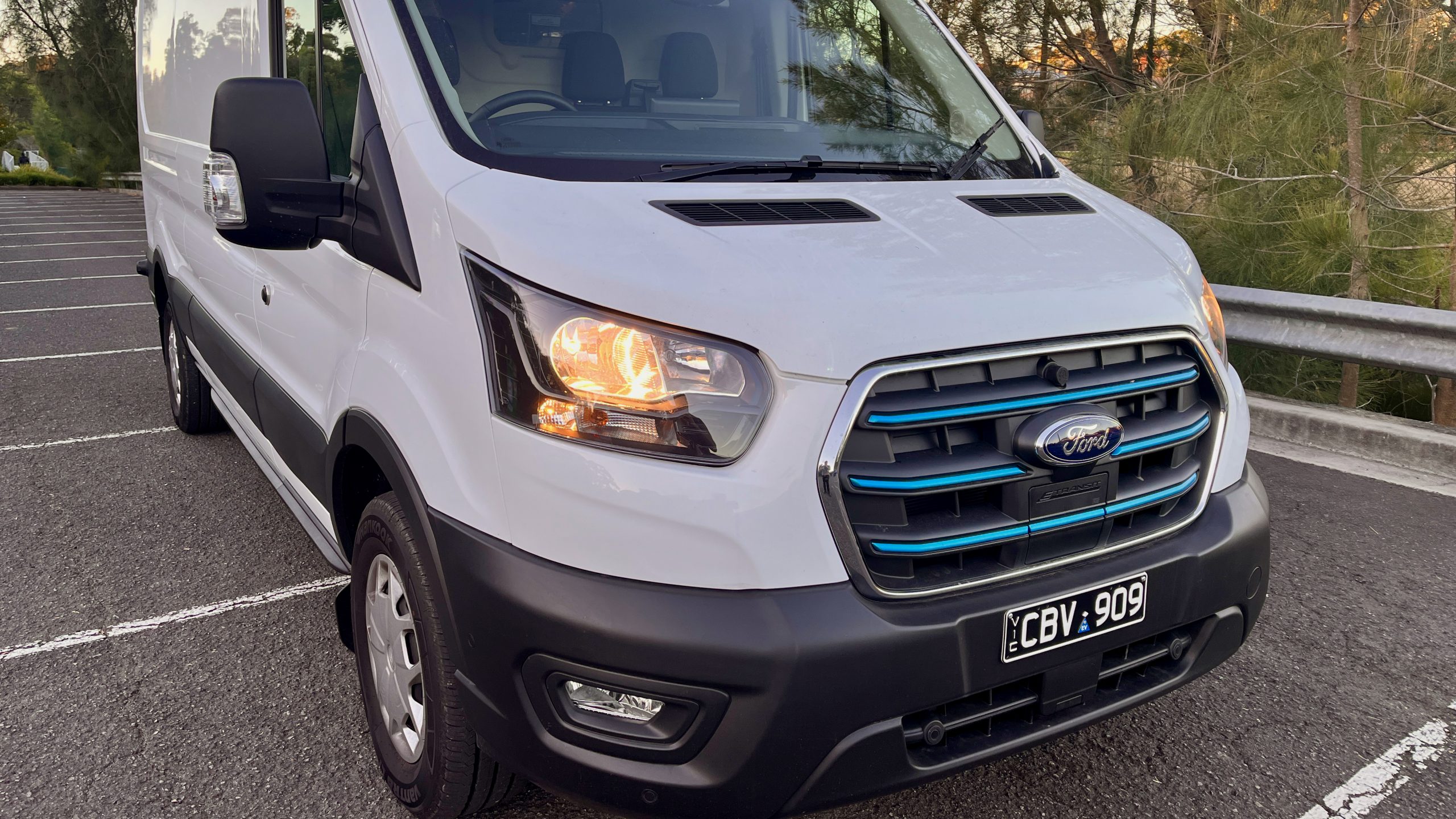
The 2023 Ford E-Transit is Ford Australia’s first fully electric vehicle offering, and we think an interesting market segment to start. The Ford E-Transit shares a lot of components with the regular diesel Ford Transit van, but apart from the obvious electrification of the drivetrain, also adds more equipment. We spent a week behind the wheel of the 2023 Ford E-Transit to find out for ourselves whether Ford Australia is onto something with its first fully electric vehicle.
Price & Equipment: 7/10
The 2023 Ford E-Transit sits at the top of the Transit range, as the sole EV variant, with every other model having a Diesel engine. The Transit range starts at $52,090 plus on road costs for the base model 350L LWB RWD Van Manual, with the E-Transit we tested retailing for an eye watering $104,990 plus on road costs – the EV drivetrain is at a $39,300 premium over the most expensive regular diesel Ford Transit.
For the money, the single equipment level of E-Transit features 16-inch steel wheels with hubcaps, automatic halogen headlights, rain sensing wipers, power-folding exterior mirrors, a glare resistant 12-inch touchscreen featuring wireless Apple CarPlay and Android Auto, satellite navigation, connected services such as weather updates and live traffic updates, automatic climate control, three stage heating for the outboard seats, an auto up/down drivers window, selectable drive modes, push button start (no keyless entry) and a four-speaker sound system.
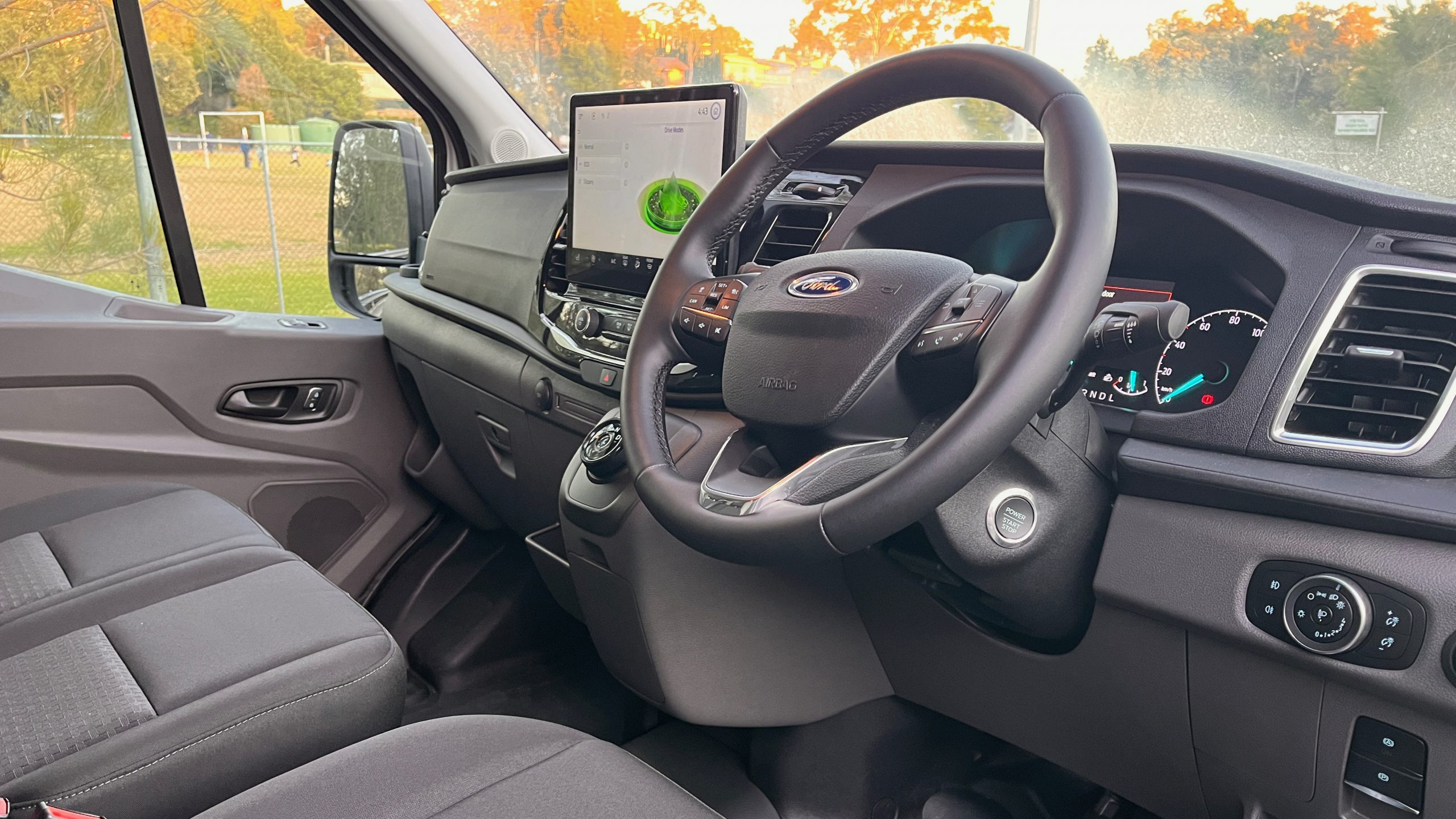
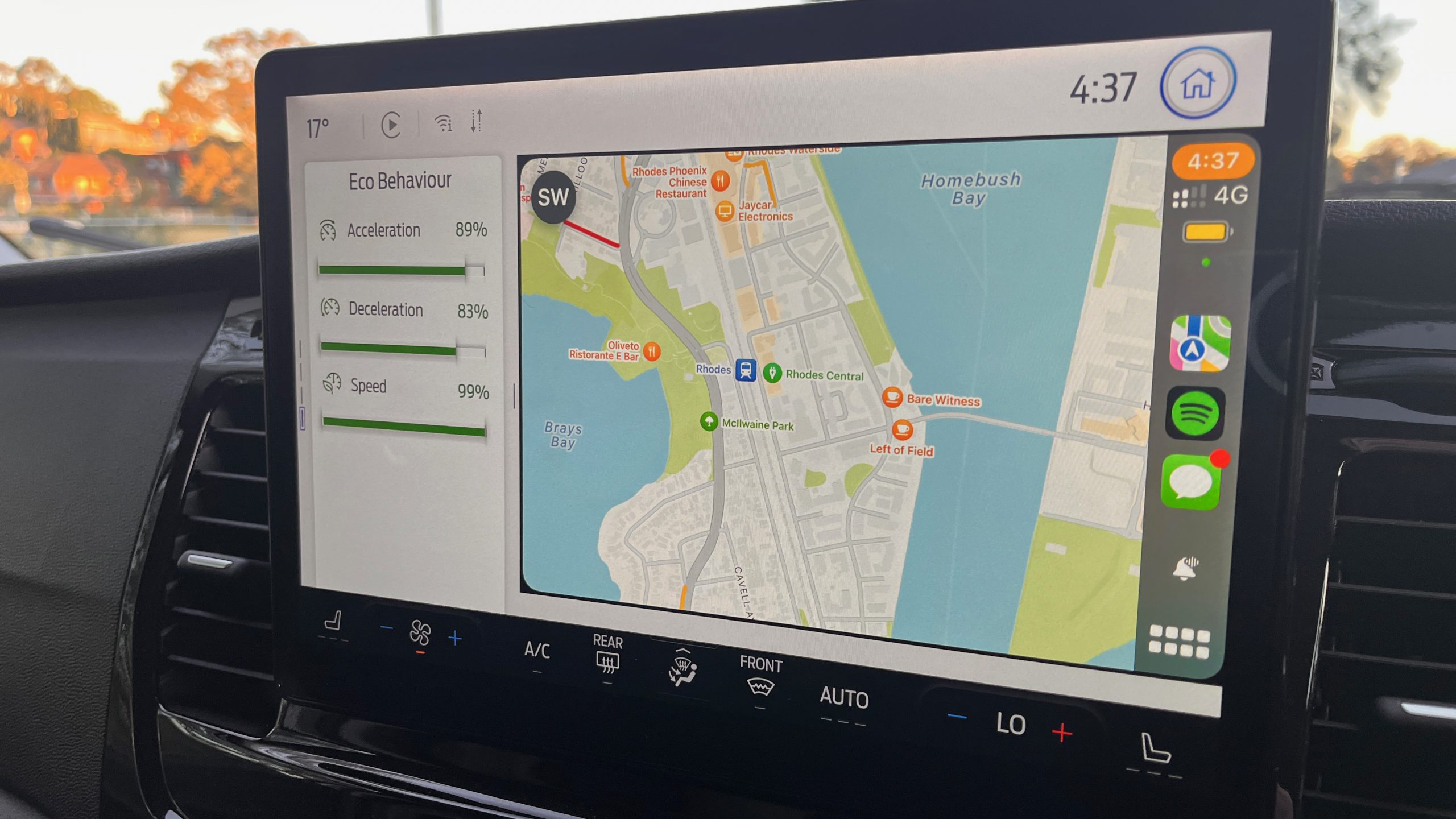
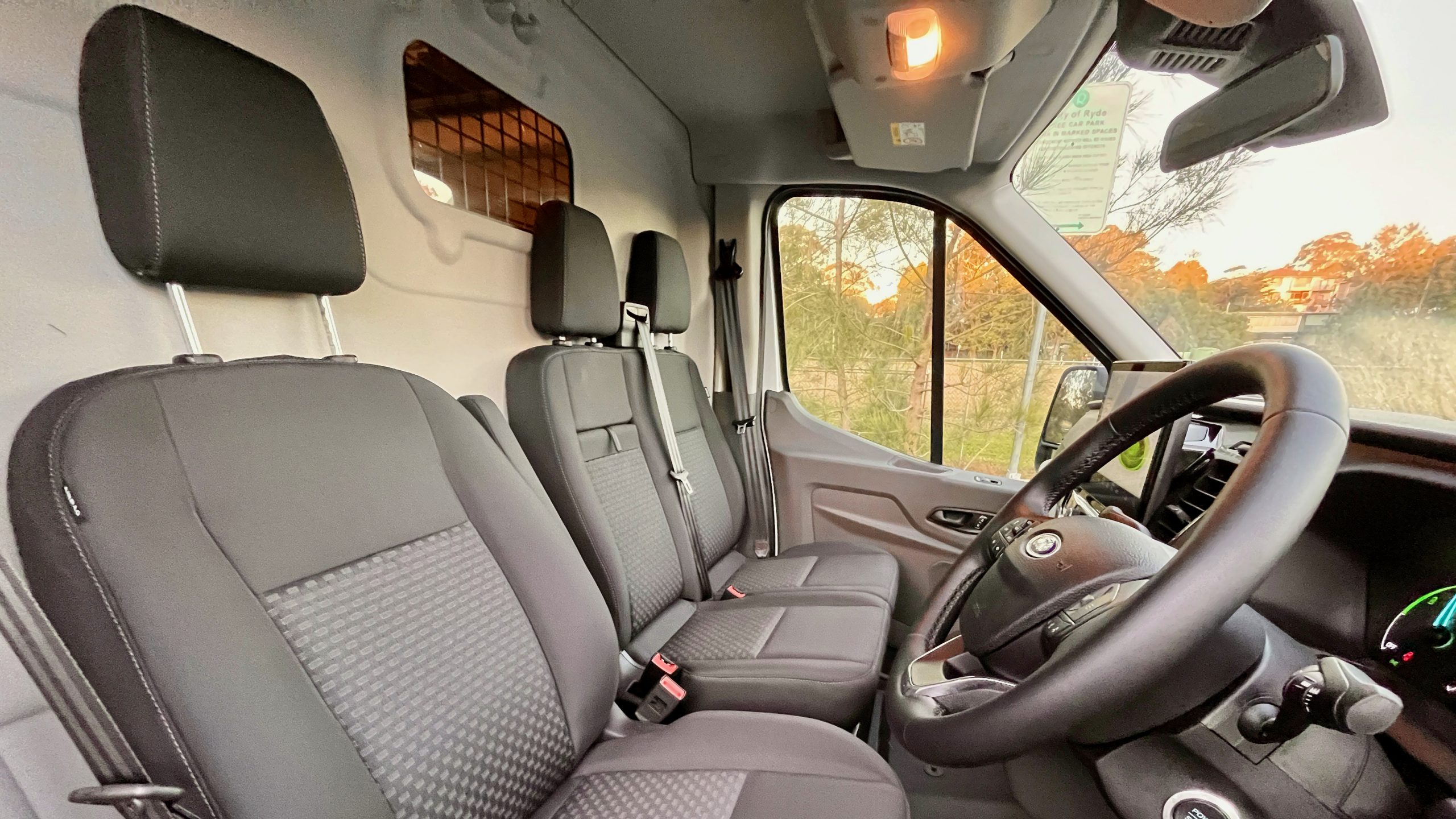
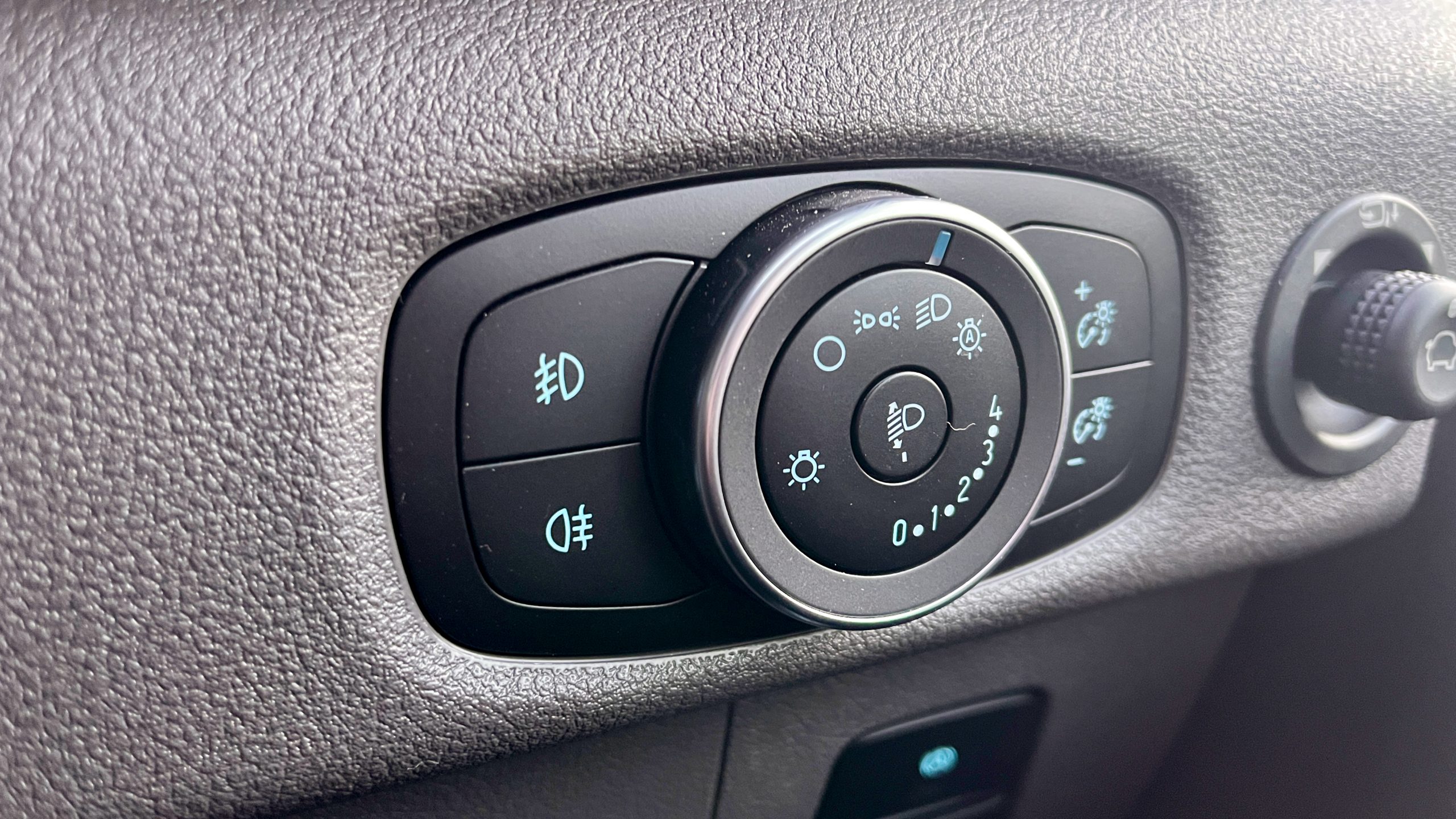
Though the current Transit range is undated by ANCAP, it does feature a plethora of safety features, which include six airbags (dual front, dual front side and front curtain), autonomous emergency braking (AEB) with pedestrian detection and intersection assist, adaptive cruise control, blind-spot monitoring, hill launch assist, lane departure warning with lane keep assist, road sign recognition, rear parking sensors with a rear view camera and an electronic handbrake with auto hold function.
Choosing the ‘high-roof’ specification raises the price by $1,500 and opting for dual-sliding doors is an extra $1,000. Pay an extra $150 and Ford will remove the middle seat and replace the passenger seat with a regular ‘bucket’ seat. The only standard colour available on the E-Transit is our test cars ‘Frozen White’ paintwork however ‘Moondust Silver’ and ‘Magnetic (Grey)’ can also be had for an additional $700.
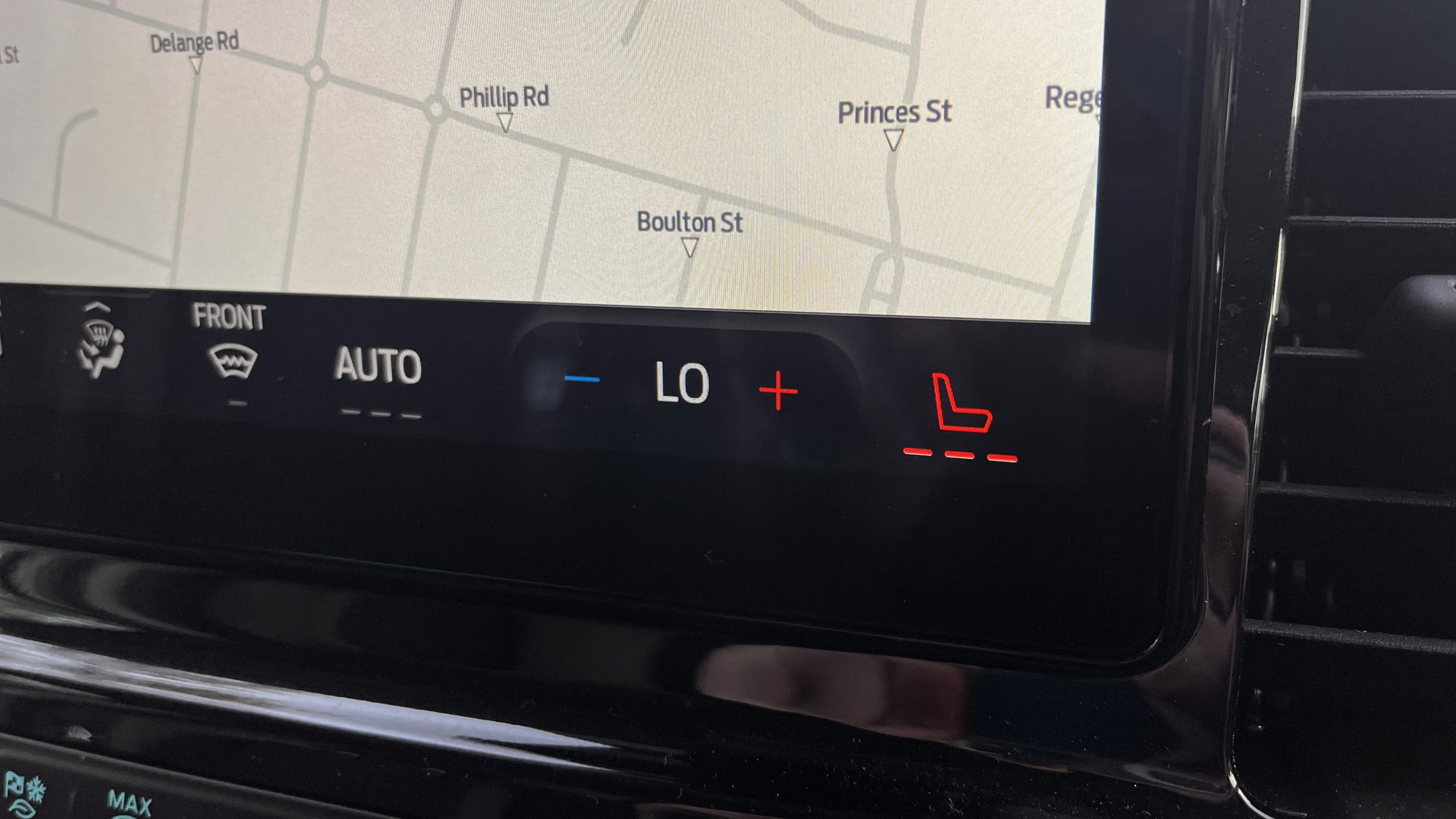
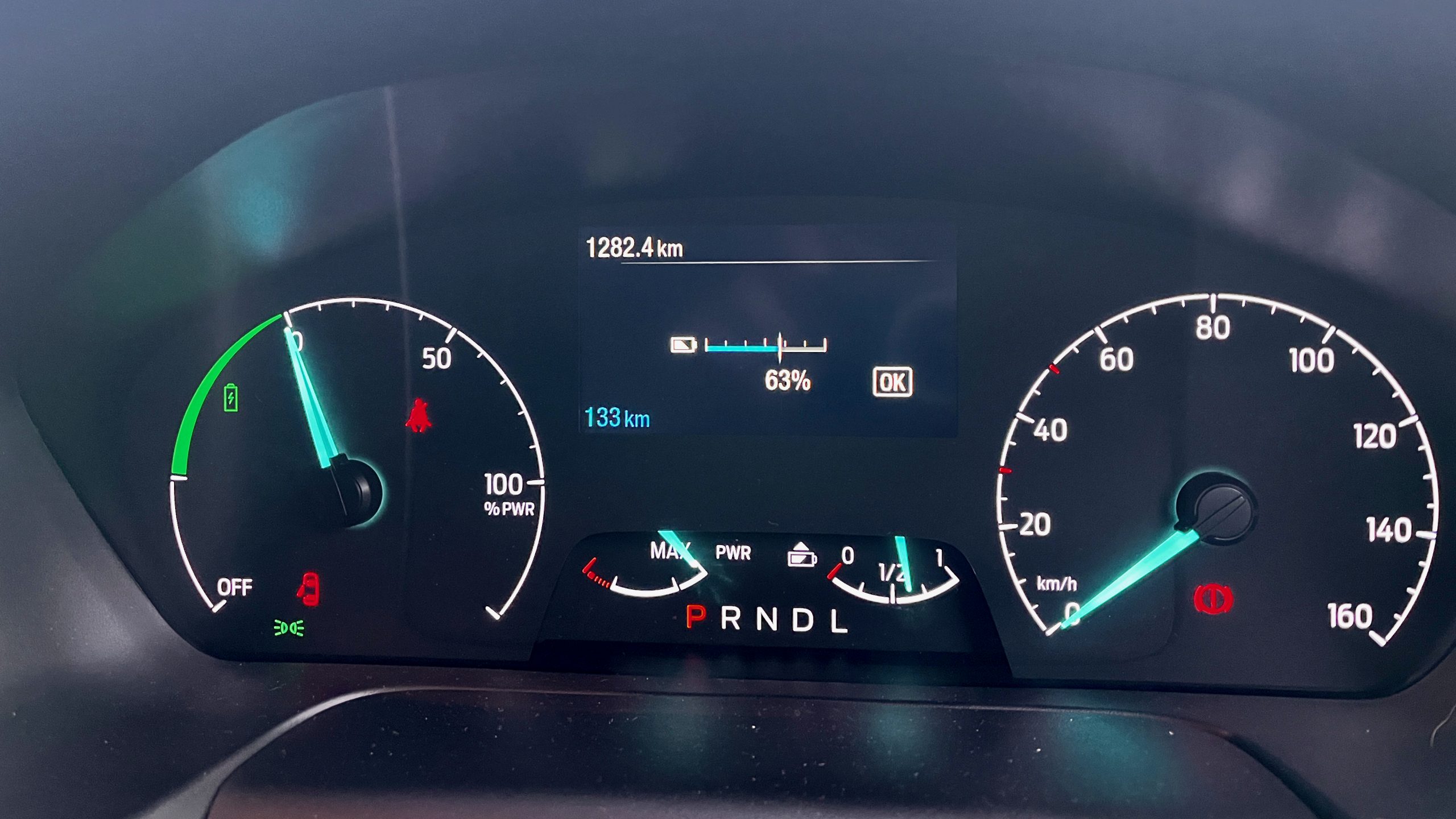
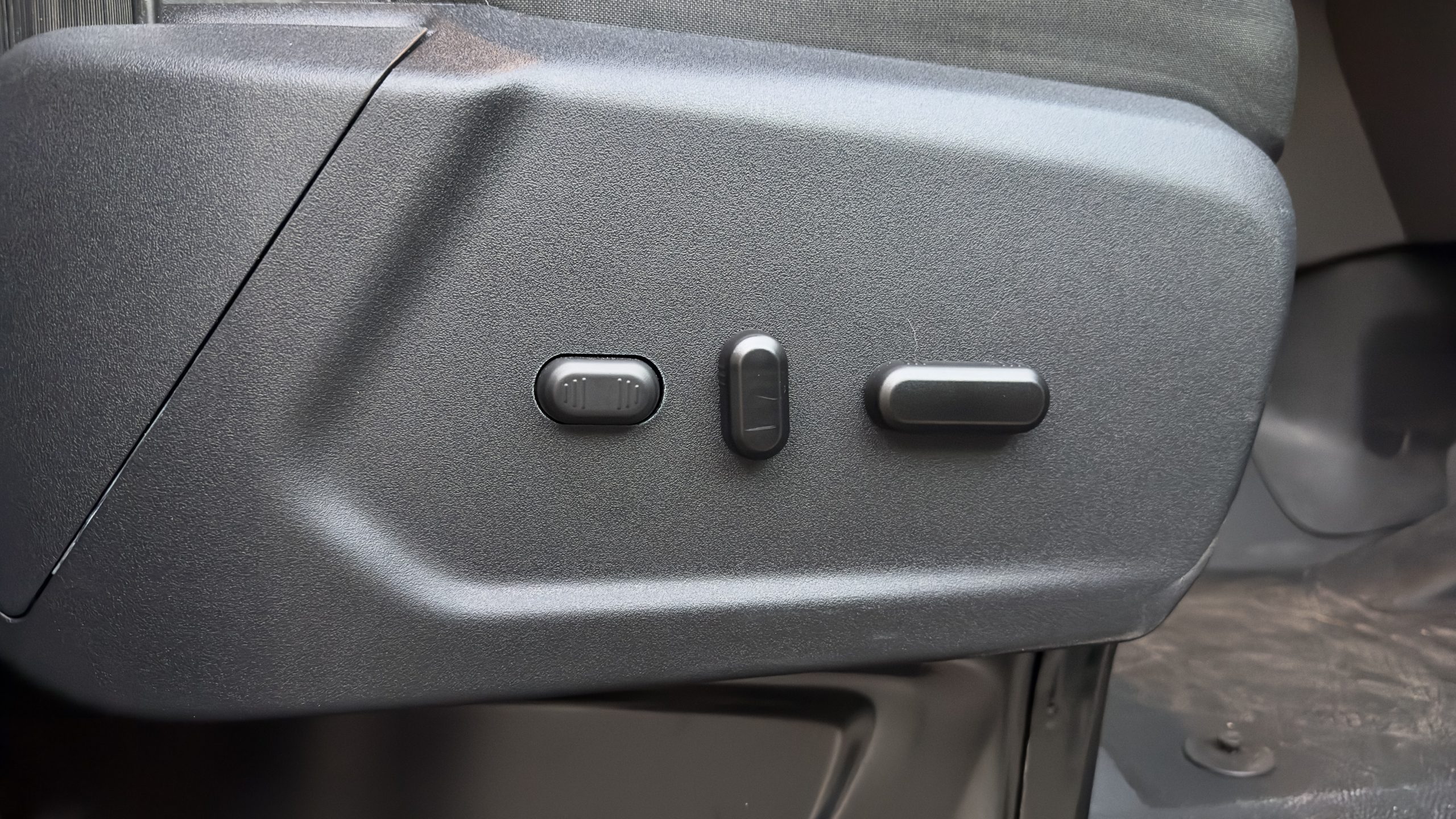
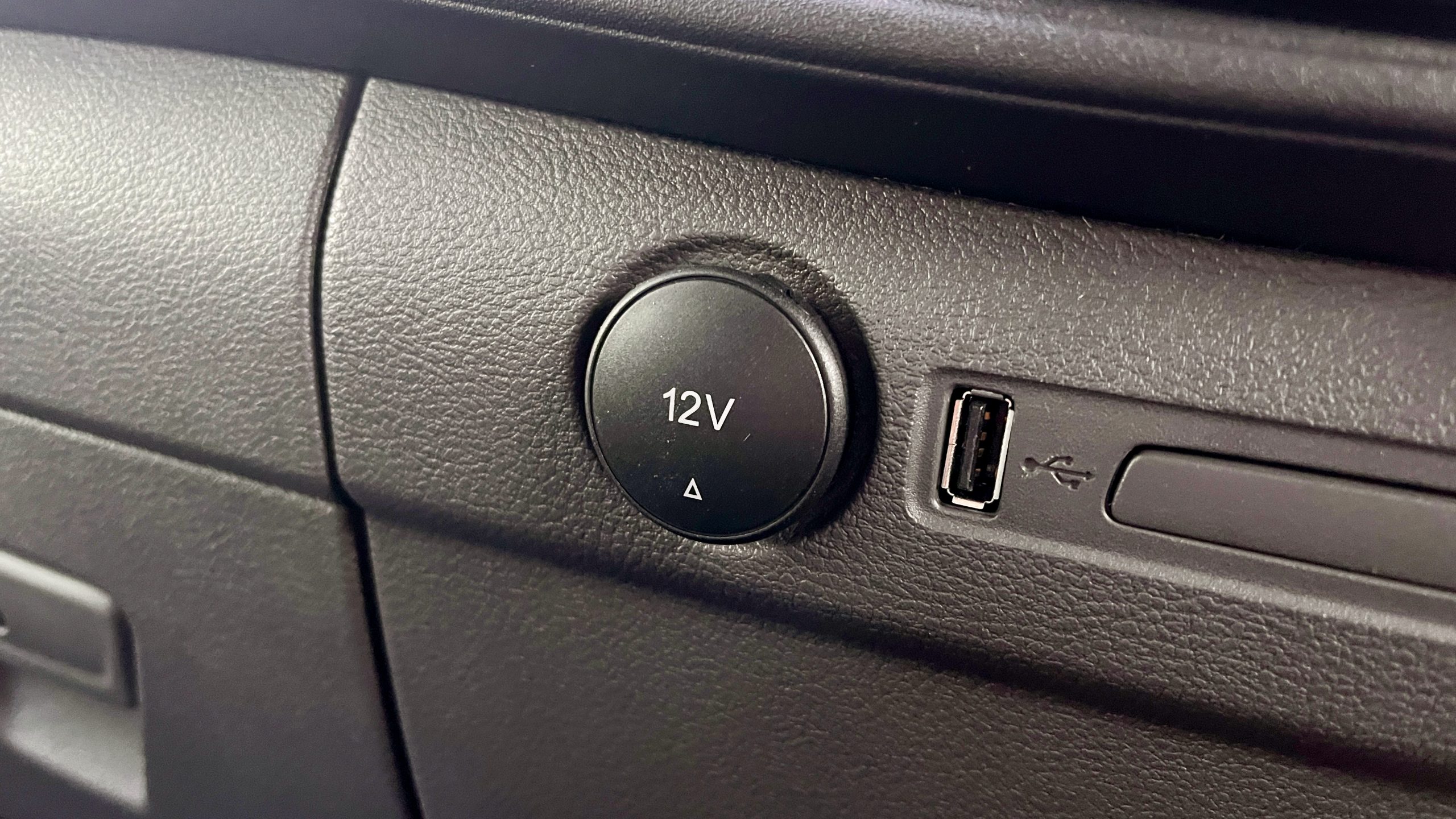
At this price point we would have liked to have seen more standard equipment to improve the value equation. Notably missing from the E-Transit are LED headlights, auto high beam, a digital instrument cluster, dual sliding doors, auto folding exterior mirrors and front/side cameras.
Australians don’t have a whole lot of choice when it comes to electric vans – the singular competitor to the 2023 Ford E-Transit, is the LDV eDeliver 9 that is priced from $118,836 plus on road costs, a whole $13,646 more than the Ford. The LDV has digital radio and full size spare wheel, which are both missing from the Ford. However, LDV is missing the larger touch screen, the full active safety suite, rain sensing wipers, power folding mirrors, heated seats, wireless smartphone mirroring and satellite navigation which are all standard on the Ford.
Performance & Economy: 7/10
The 2023 Ford E-Transit is powered by a single electric motor, mounted under the load floor in the rear of the van. The powertrain produces 198kW of power and a healthy 430Nm of torque, supported by a 68kWh battery.
The drivetrain delivers the smooth acceleration that EV drivers are well accustomed to. Even though the E-Transit is neither small or light, electric propulsion gives it a feeling of nimbleness. Power is sent to the rear wheels by a singular gear setup, which is as expected, smooth. While it’s obviously no sports car, the instant torque delivery overcomes the turbo-lag of many diesel vans making getting up to speed quick. The power to weight ratio of the E-Transit is 17.9kw/t – higher than the 4cyl 2.0L turbo diesel engine in the regular Transit range.
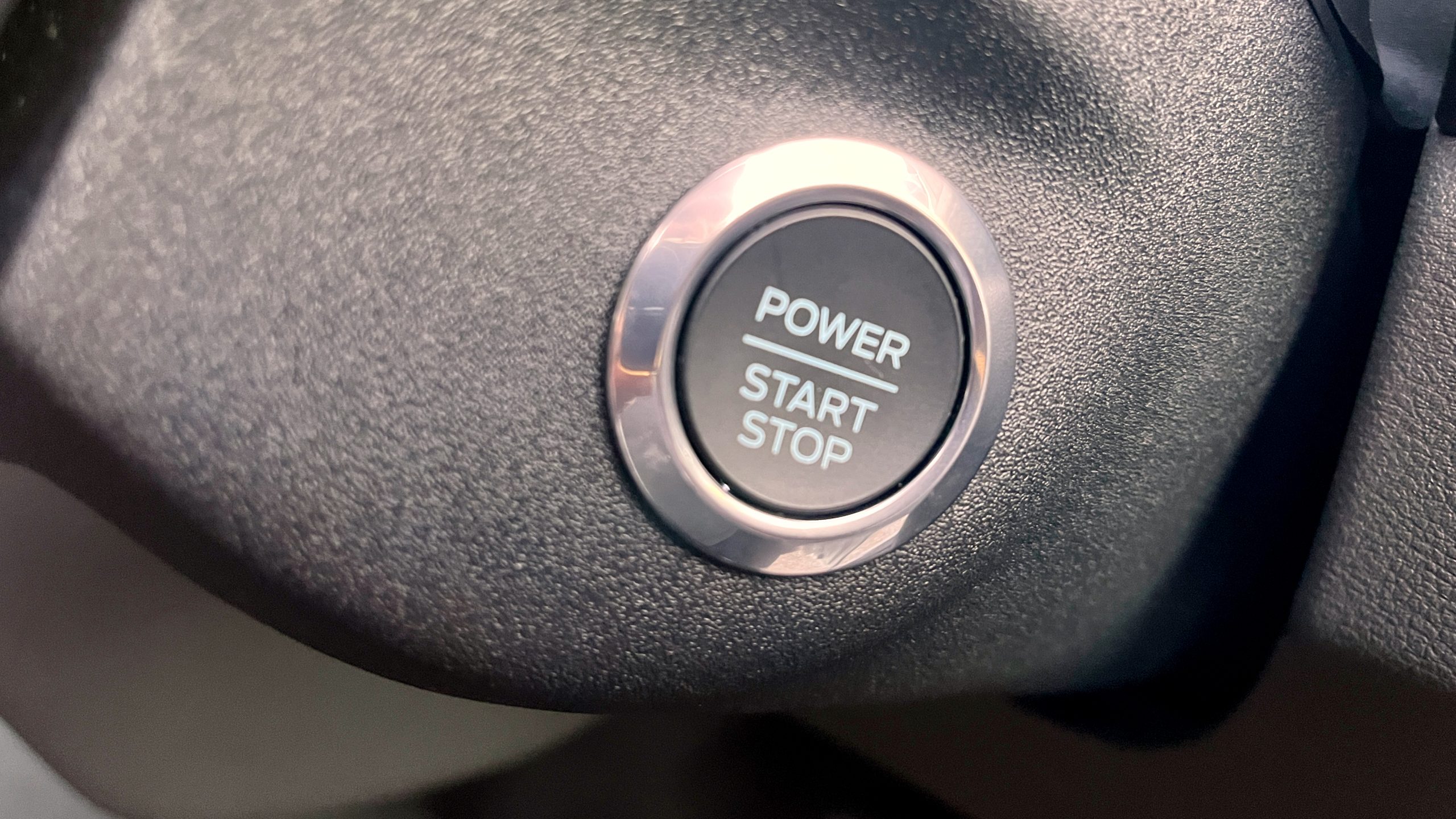
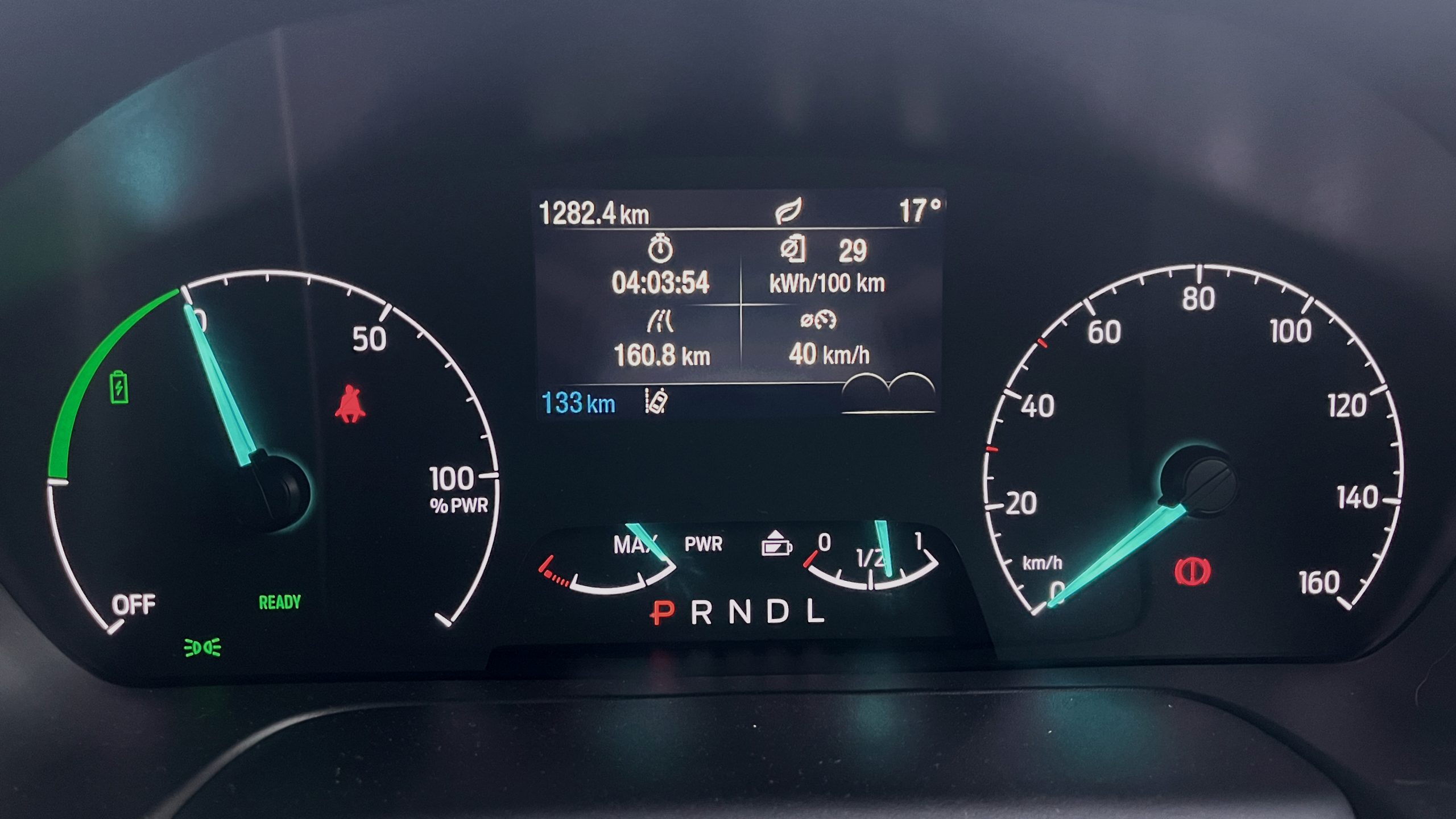
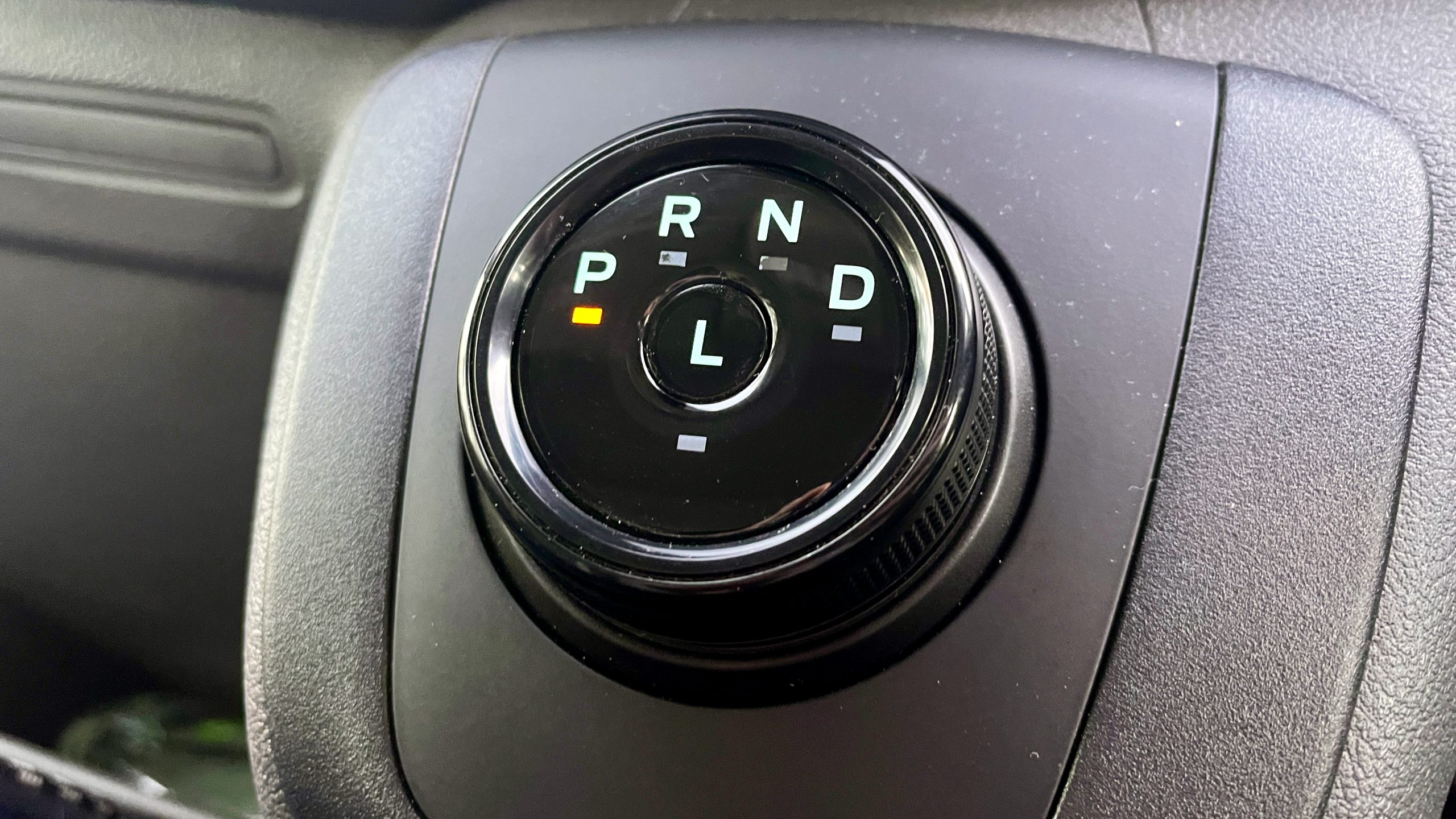
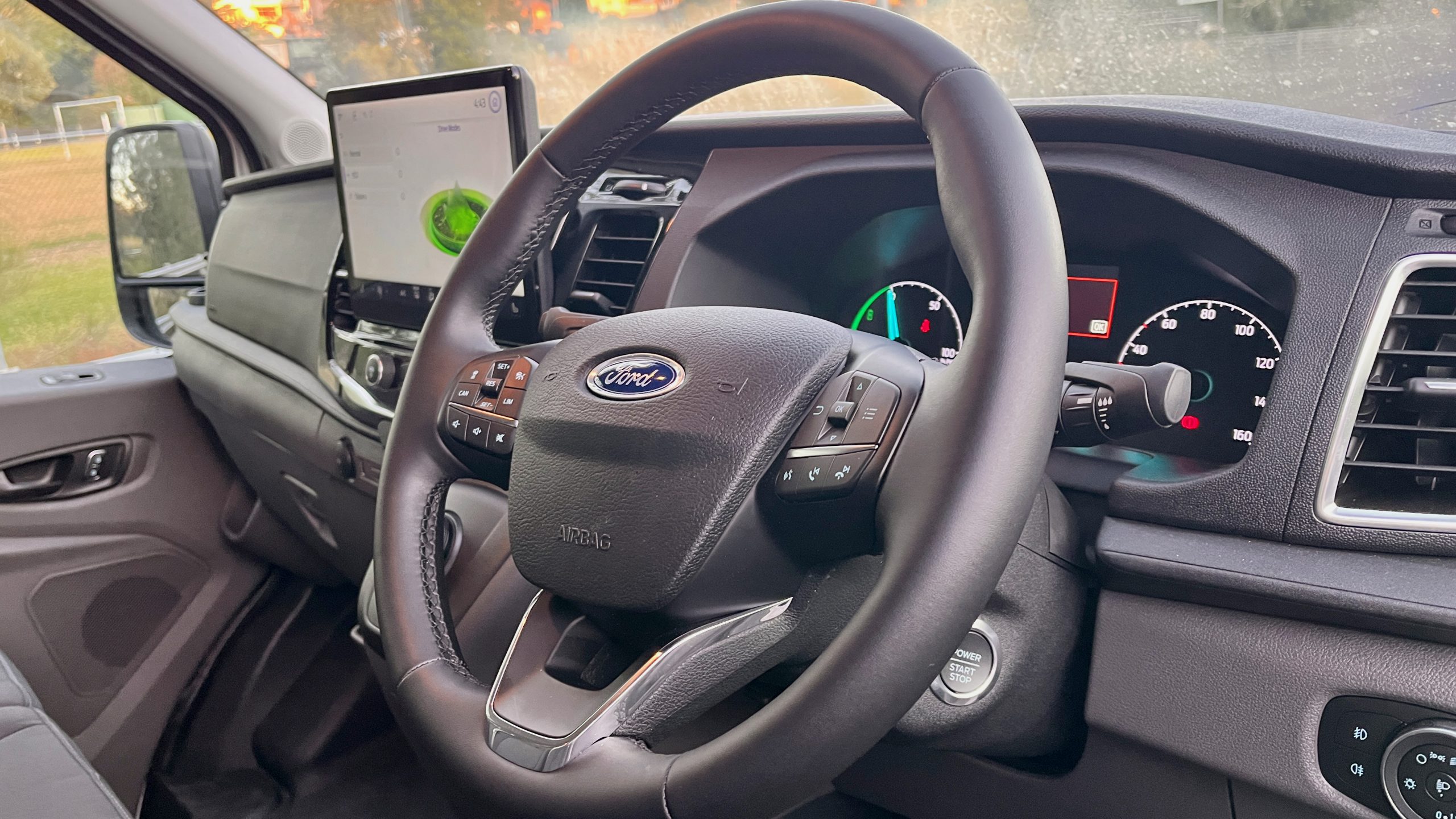
Ford quotes a range of 307km on a battery charge for the ‘mid roof’ option and a reduced range of 295km for the ‘high roof’ option that our test van was fitted with, by the WLTP standard. In practice though, after a week of mixed driving, we averaged electricity usage of 26kWh/100km and a range of around the 245km mark from a full charge – and this would be worse if it had been loaded. This figure is pretty low, so we do question the practicality of the E-Transit doing duty as a delivery or tradesperson’s van, but we can see the viability for those who don’t need to cover large distances each day.
With fast DC charging support up to 115kW, the E-Transit can be charged from 15 per cent to 80 per cent in about 34 minutes. Charging the 2023 Ford E-Transit with an AC wall-box at a maximum rate of 11.3kW with the included charging cable takes around eight hours and 10 minutes, which should be quick enough to charge the E-Transit overnight. Ford unfortunately doesn’t include a 240 volt household plug trickle charger with the E-Transit for emergency situations. The regenerative braking in the 2023 Ford E-Transit is very subtle and doesn’t change the driving experience too much. We wish there were more options for higher levels of regenerative breaking, to capture more energy and possibly improve range.
There are three different driving modes on the E-Transit: Normal, Eco and Slippery. Normal mode is the default drive mode. Eco mode is tuned to optimise driving range by limiting the maximum speed to 110km/h, regulating acceleration, and optimising the climate control. Ford say that this will improve the vans efficiency by 8-10% when the van is unladen. Slippery mode will improve traction in low-grip situations by limiting power and tuning the traction control system to manoeuvre out of potentially sticky situations.
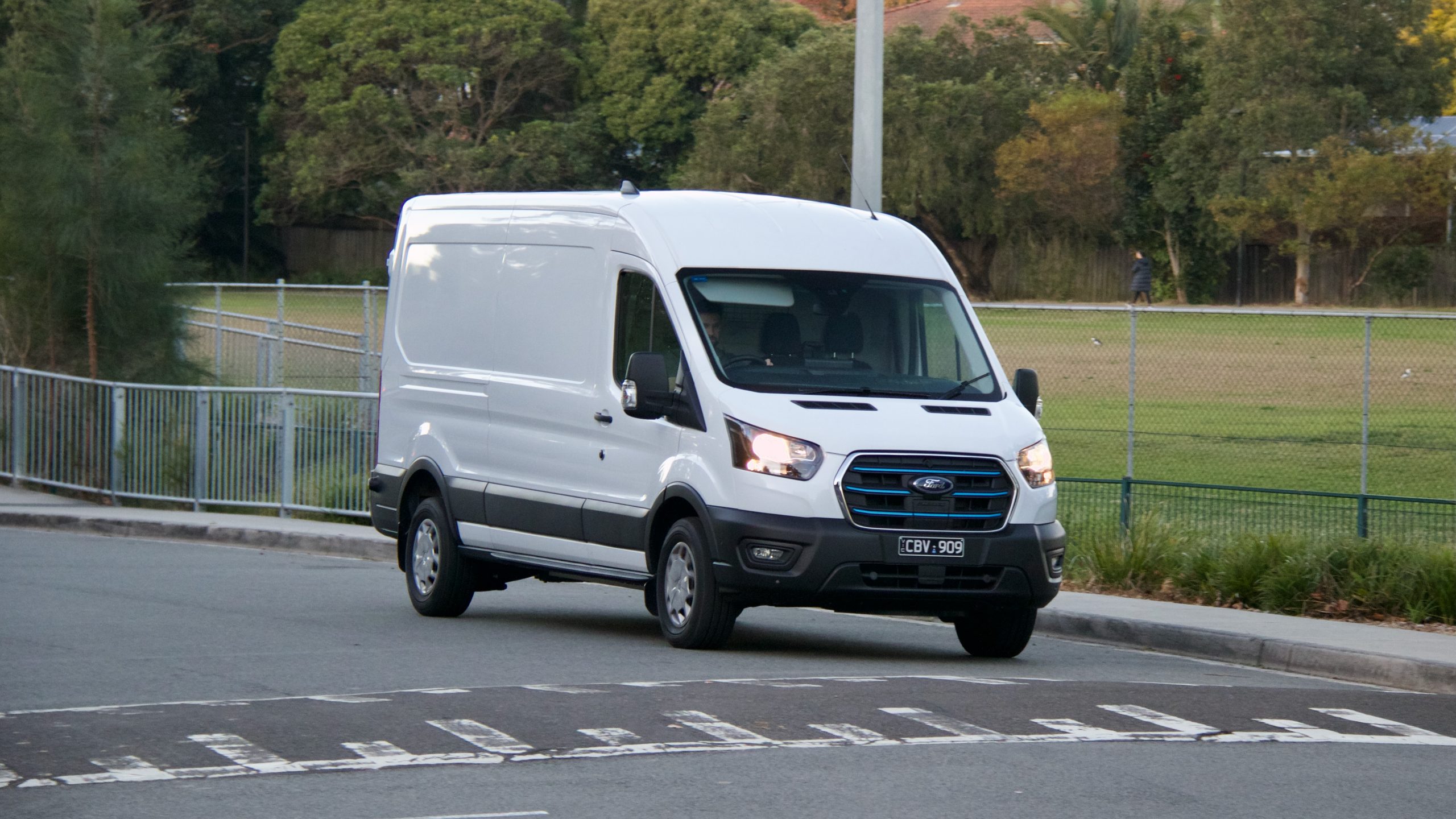
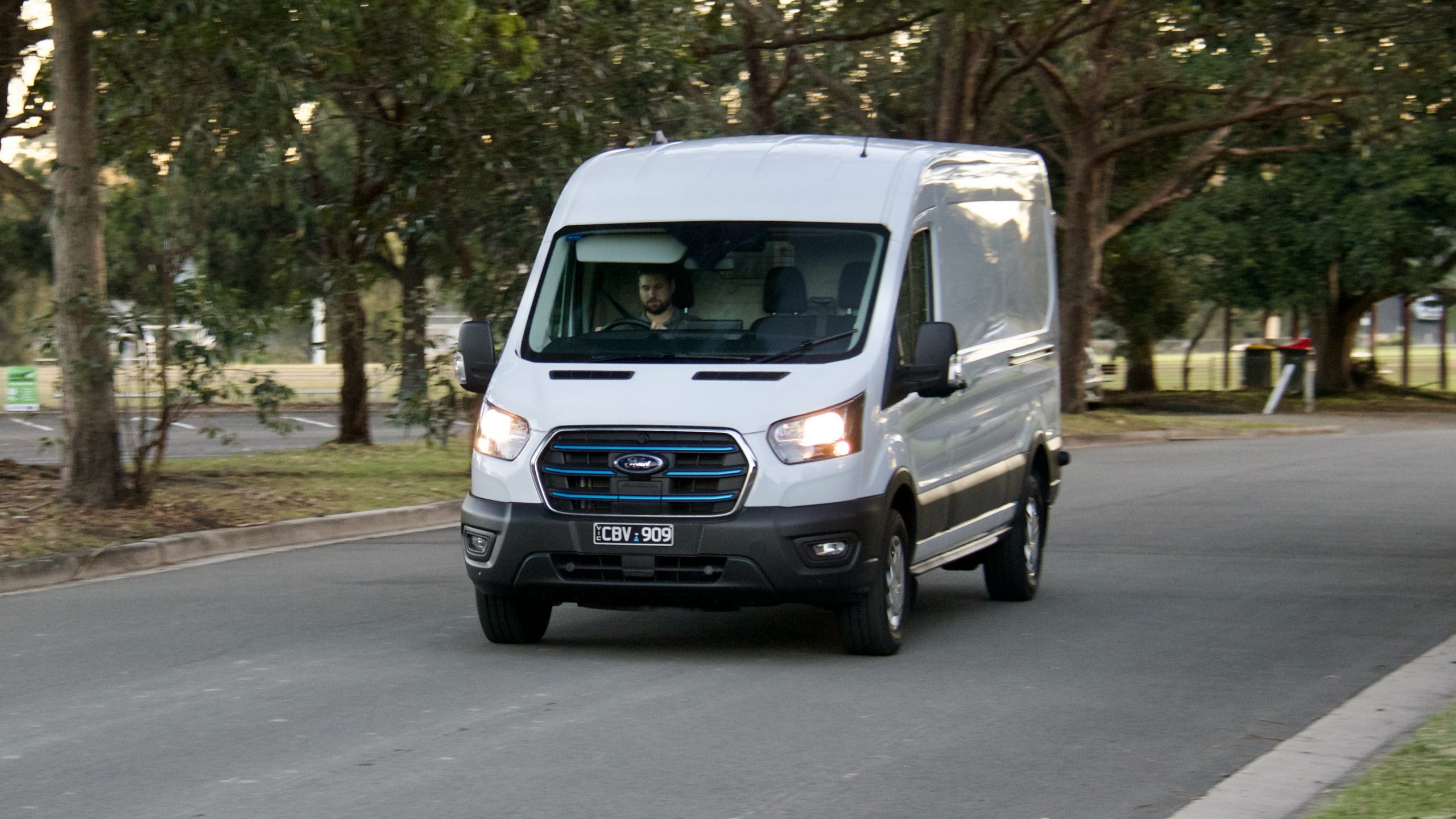
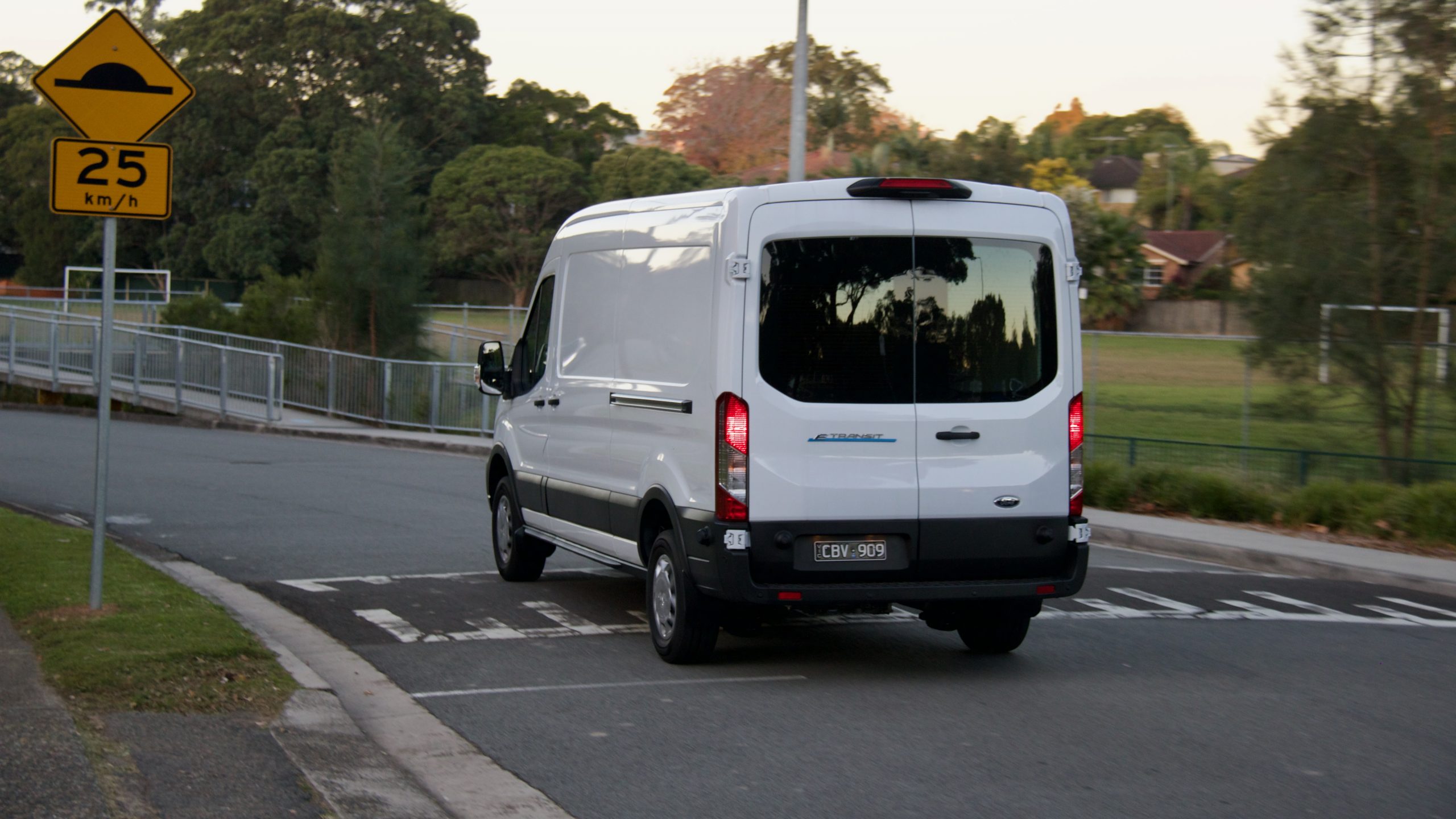
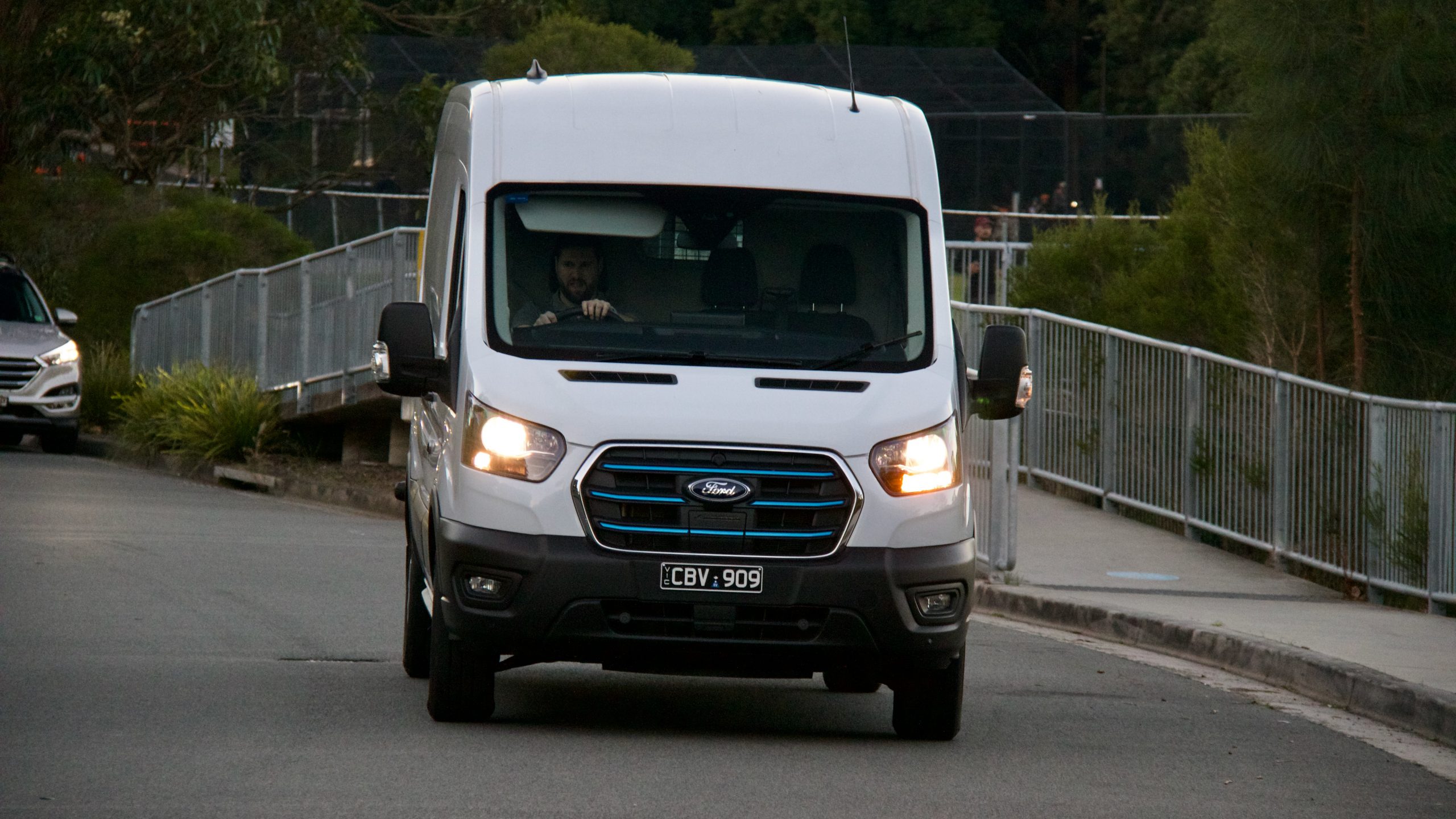
Oddly enough, with no tow bar kit, or option to add one, the 2023 Ford E-Transit has no towing ability. Ford says that using the E-Transit to tow anything, will void the warranty. We think that this is a strange omission in a vehicle whose target market includes tradespeople who might want to use their van for towing purposes.
In comparison the LDV eDeliver 9 comes with a larger 88.5kWh battery pack, but with a claimed driving range of 275km (less than the Ford). It produces 150kW of power and 310Nm of torque (48kW/120Nm less than the E-Transit). A spec by spec comparison of the eDeliver 9 and the E-Transit doesn’t do the LDV any favours, but we’d wait to compare the real world range of the LDV before making any firm judgments.
Ride & Handling: 9/10
There is no getting around the large exterior dimensions of the Ford E-Transit, and behind the wheel, the length and width of the E-Transit are hard to escape. However, while many unladen vans can tend to have a choppy ride, the Ford E-Transit rides quite well with nothing in the back . We have a feeling this is due to the extra weight of the battery. We found driving the E-Transit to be more than comfortable enough, with the suspension soaking up most of what the road could throw at it, with aplomb.
The high centre of gravity and sheer mass of the Ford E-Transit don’t do it any favours in the handling department, though it still manages to provide an overall competent handling experience. There is a bit of body roll which is to be expected as it is no sports car – nobody is going to be punting an E-Transit through corners. That being said, even with the significant added weight of the batteries, we’ve definitely driven vans which are worse at handling. The E-Transit does feel remarkably solid on the road and doesn’t have that tinny feeling that a lot of vans do. Overall, for the most part we liked that driving the E-Transit feels more like a large SUV, than a commercial van.
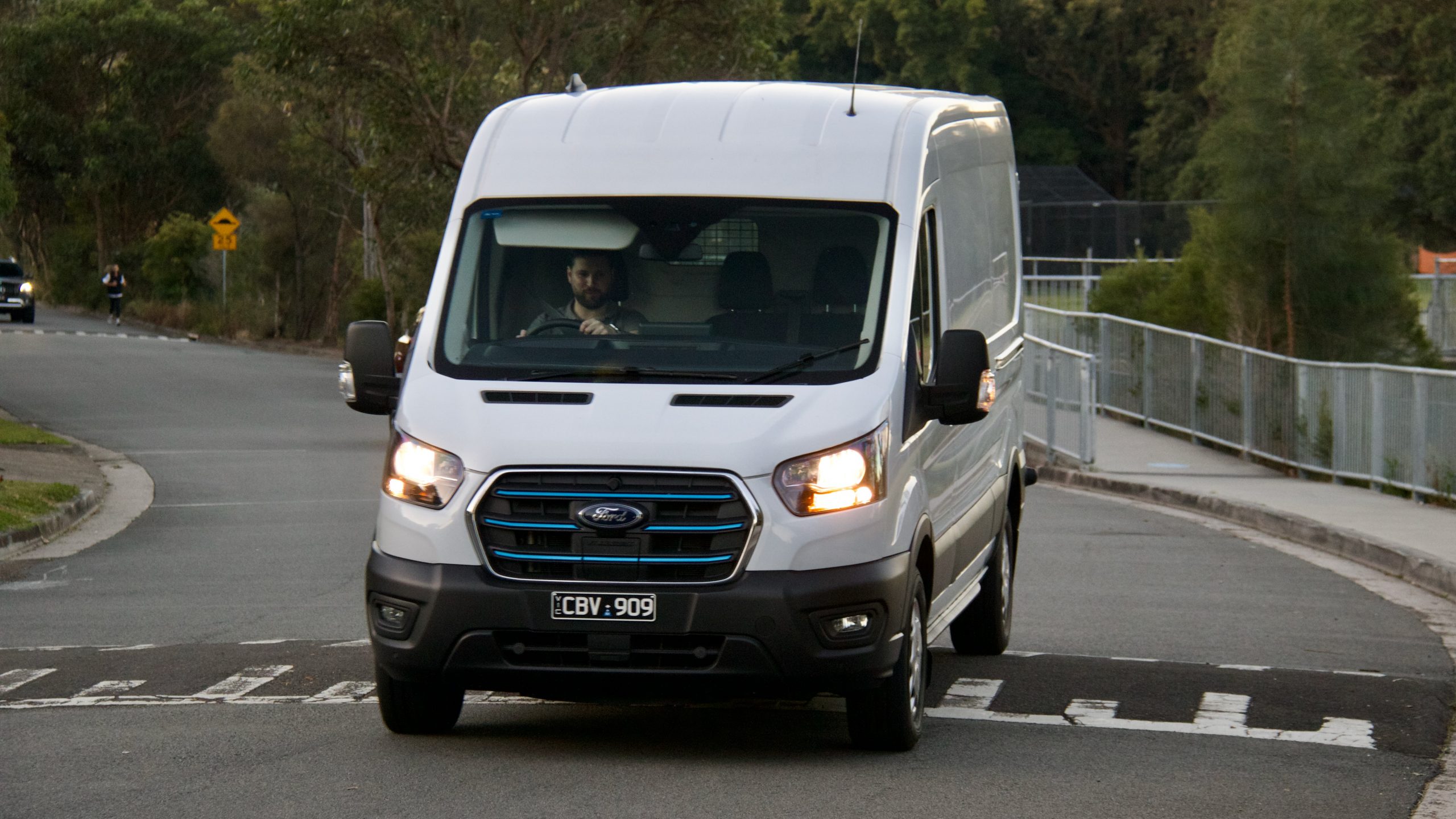
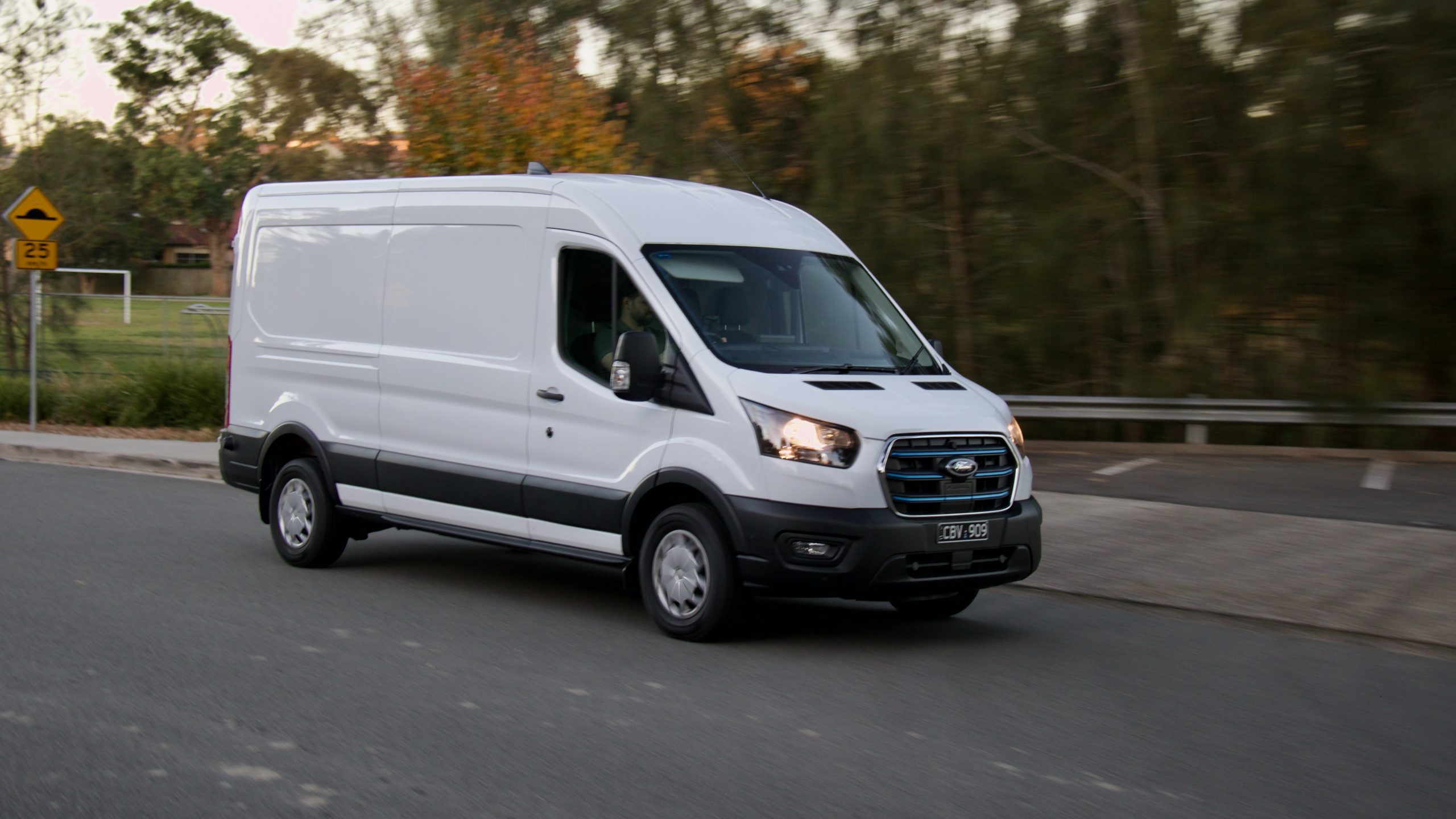
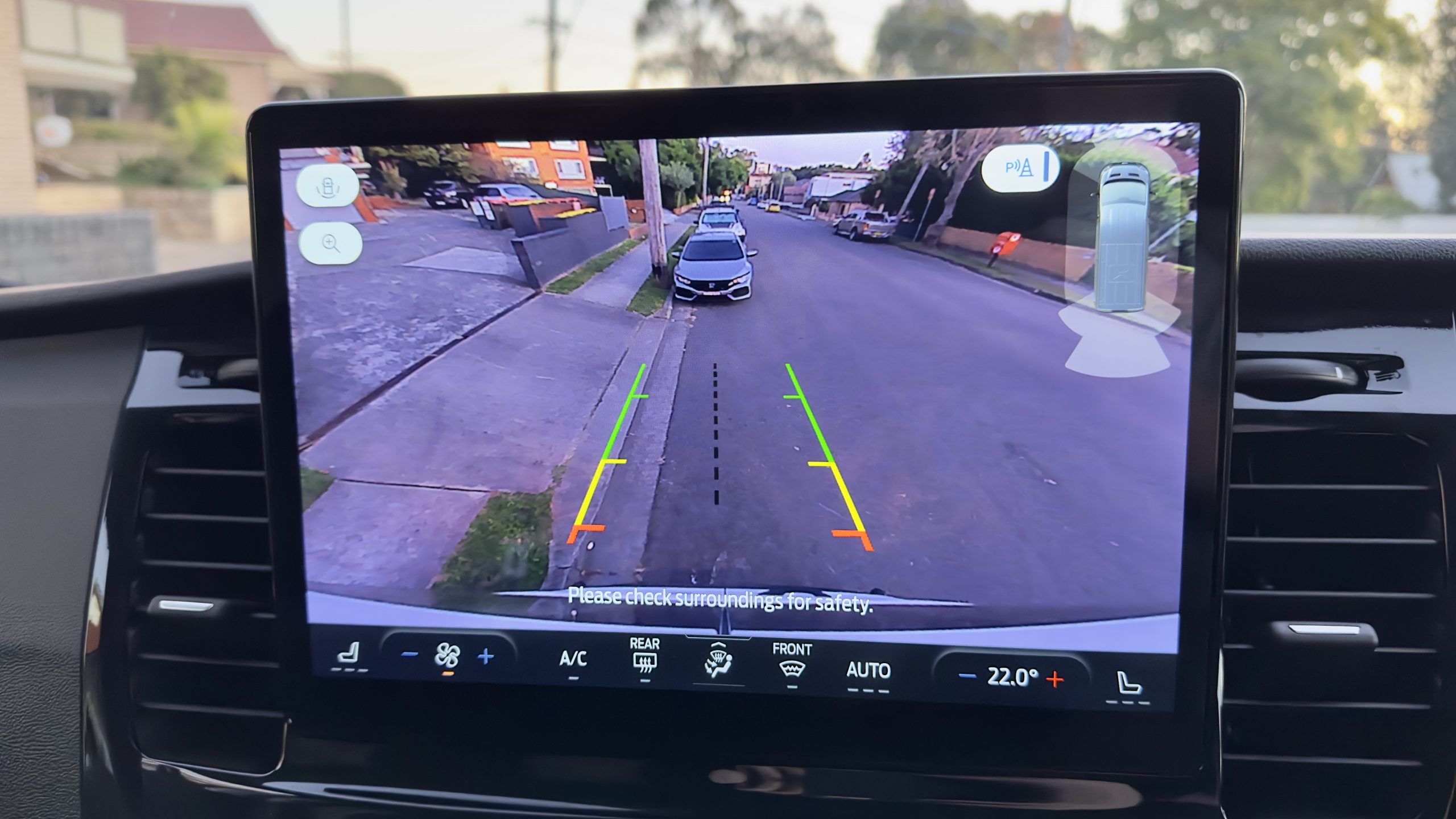
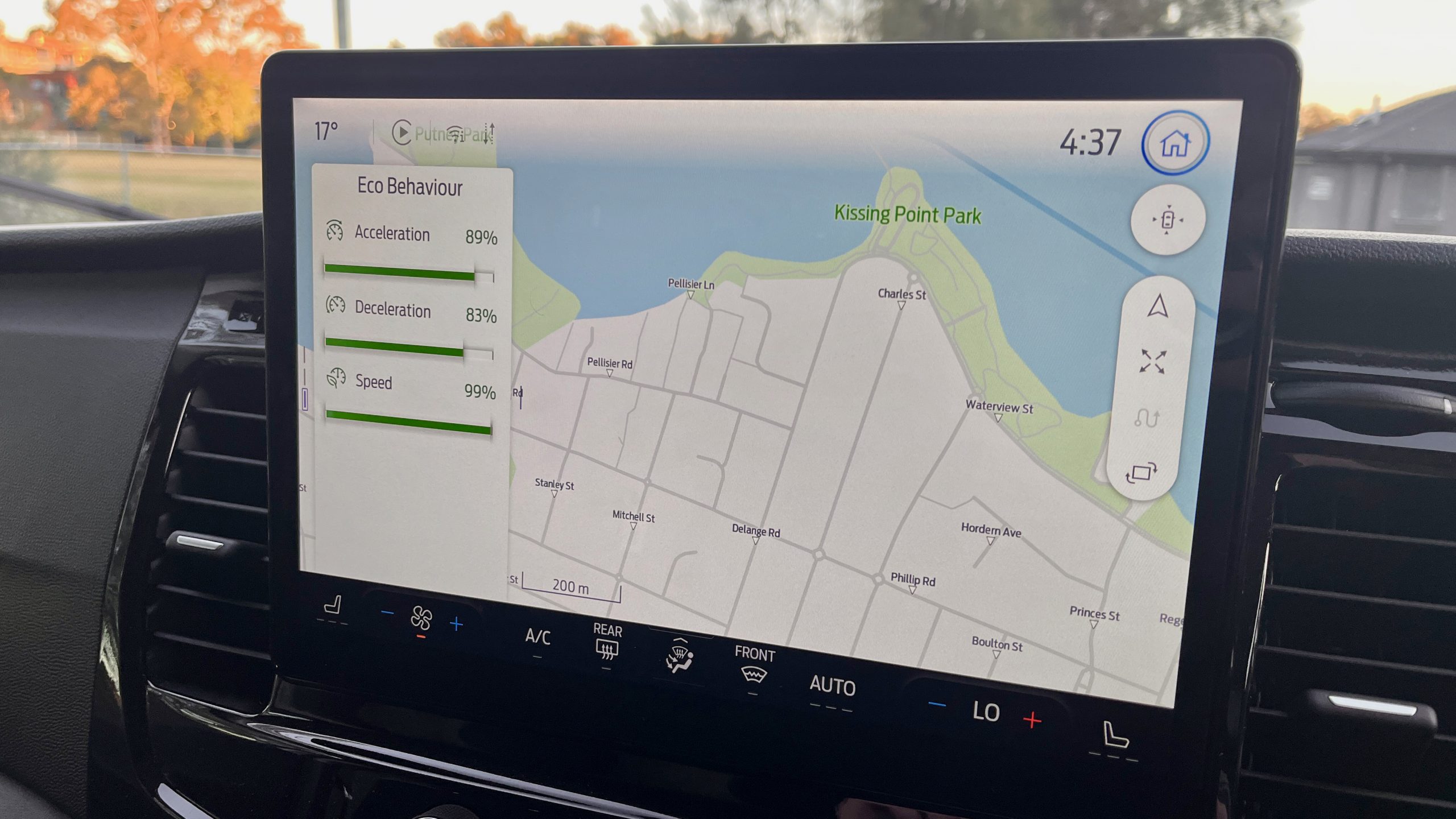
We were impressed with the direct feeling and well weighted nature of the steering, which makes manoeuvring the E-Transit a lot easier than expected – boding well for the city based duties that the rather low battery range might suggest.
We appreciated that the suite of active safety features worked quite well without interfering to0 much with the driving experience. The lane departure warning with lane keep assist is subtle and will nudge you back into your lane if it senses you straying, the forward collision alert the overly sensitive nature we’ve seen in some other systems.
Interior & Practicality: 8.5/10
Hoping into the cab of the 2023 Ford E-Transit reveals a modern space, but one that’s clearly commercial in nature. There are a lot of hard scratchy plastics throughout the cabin, and while this is to be expected in a commercial vehicle, we’d have liked to have seen some soft touch materials at this price point. While not premium to the touch, the materials all felt sturdy and well wearing. Switchgear quality throughout is great – with impressive tactile feedback.
The storage on offer is fantastic with plenty of space for tucking everything a tradesperson or delivery person might need to store. There are multiple overhead storage bins, a cupholder on each side of the dash, a fold down cup holder under the gear selector and storage by the drivers right knee and passengers left knee for a bottle. Further bolstering practicality are the large, deep door bins, a decently sized glove box, storage on the dash itself and more storage to the left of the gear selector. If this isn’t enough, there is a large storage space under the passenger seat.
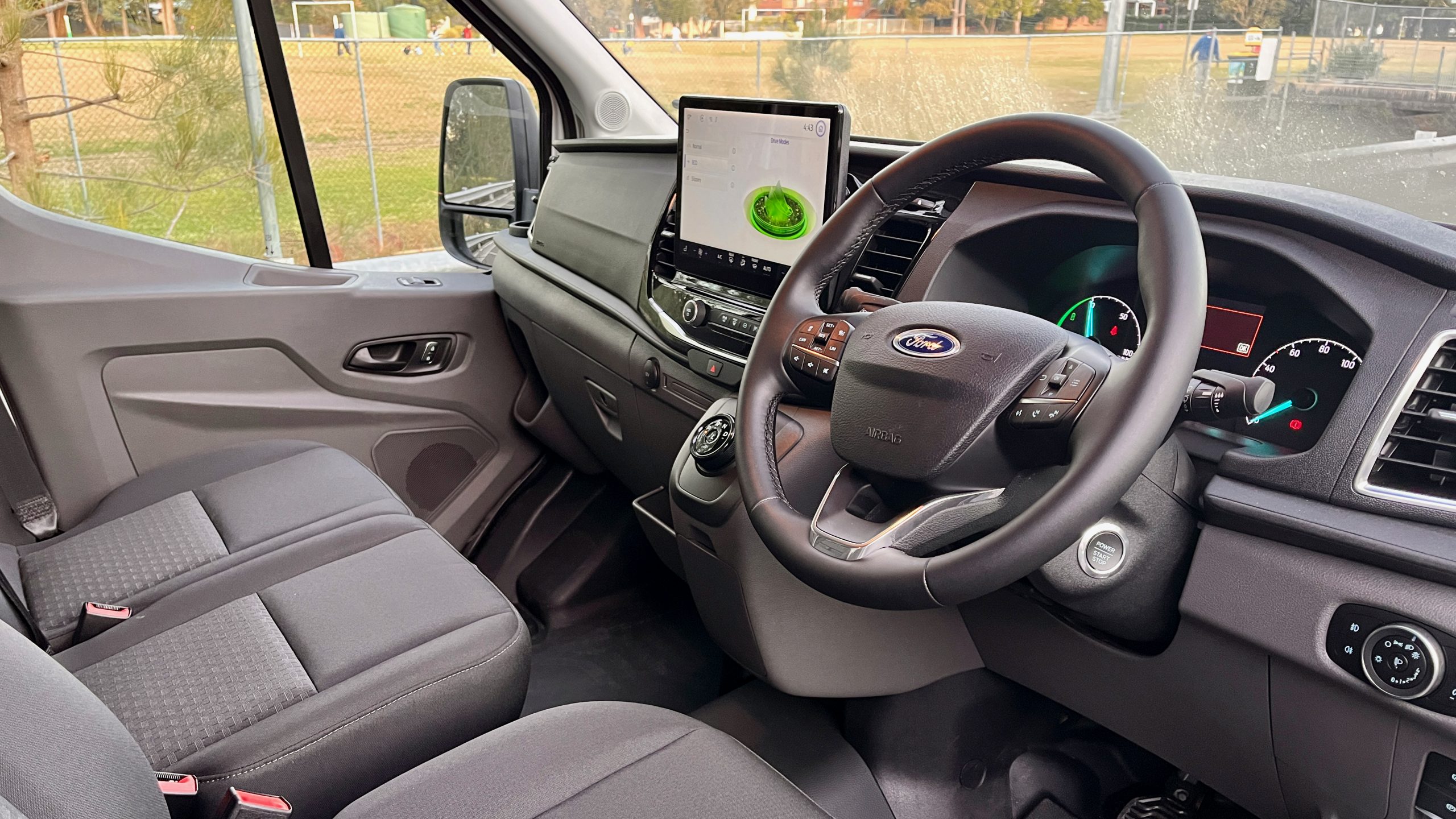
The cloth used on the seats in the E-Transit is nice to touch and the seats themselves are comfortable, with good bolstering and enough adjustment which would allow most drivers to find a suitable driving position. The three stage seat heating is also a nice touch for cold winter mornings. The standard three seat layout is very handy for those wanting to transport an additional passenger, though buyers can opt for two bucket-seat layout for an extra $150.
Ahead of the driver, sits a large instrument cluster with an analog ‘power meter’ and speedometer flanking a small digital display. The design is extremely basic, and the display itself is limited in functionality. It does the job, but at the price point, we’d expect a larger display, or even a fully digital display.
The 12-inch touch screen which takes up pole position on the dash features a great resolution and responsiveness, and makes the interior feel quite modern. The software is intuitive with pleasing graphics and a logical menu layout. The screen runs Ford’s latest SYNC 4 infotainment software, which may arguably be slightly less intuitive to operate as the last gen SYNC 3 software, but compared to other infotainment software used in competitors, is still one of the more user friendly systems we have used.
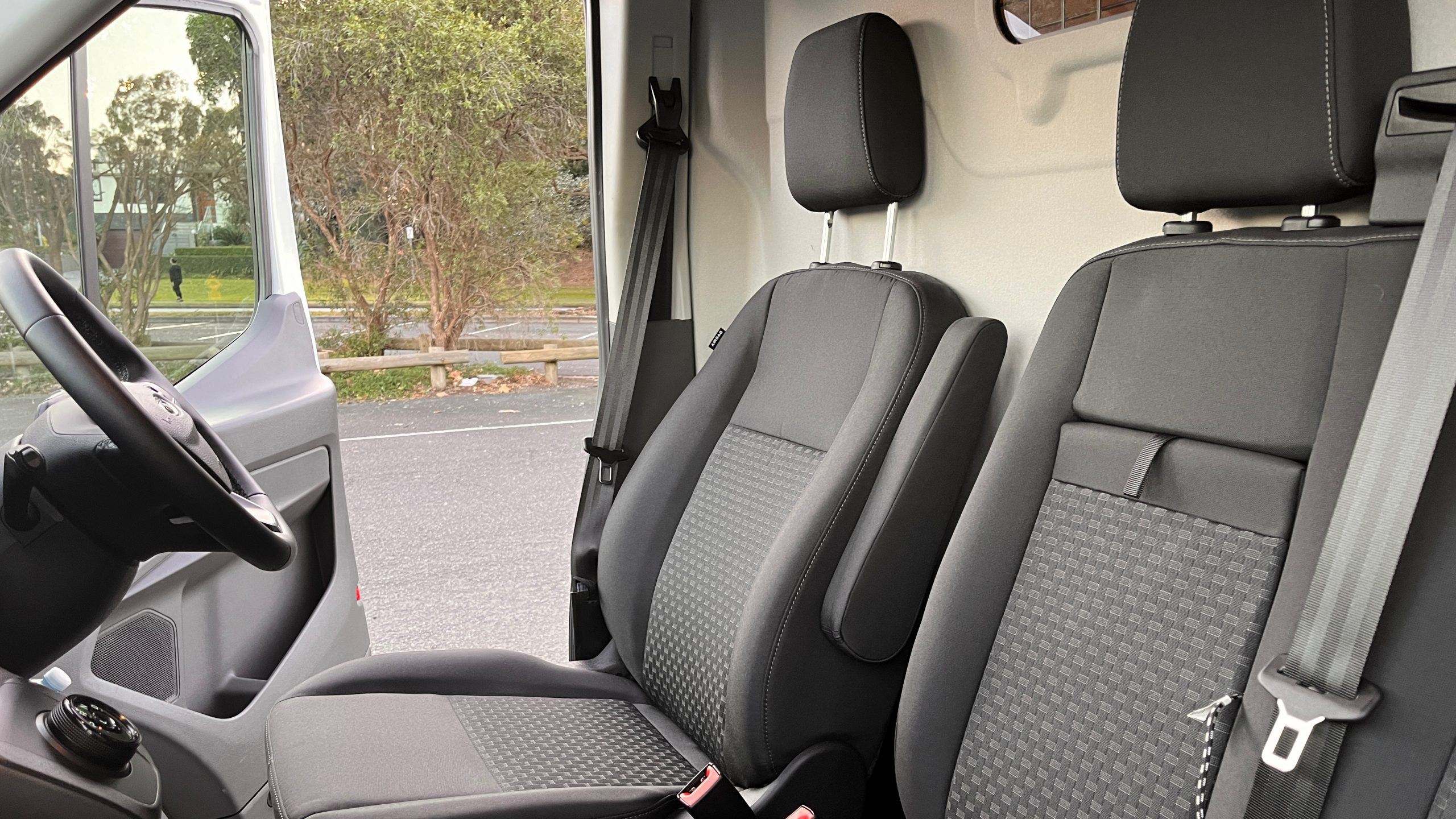
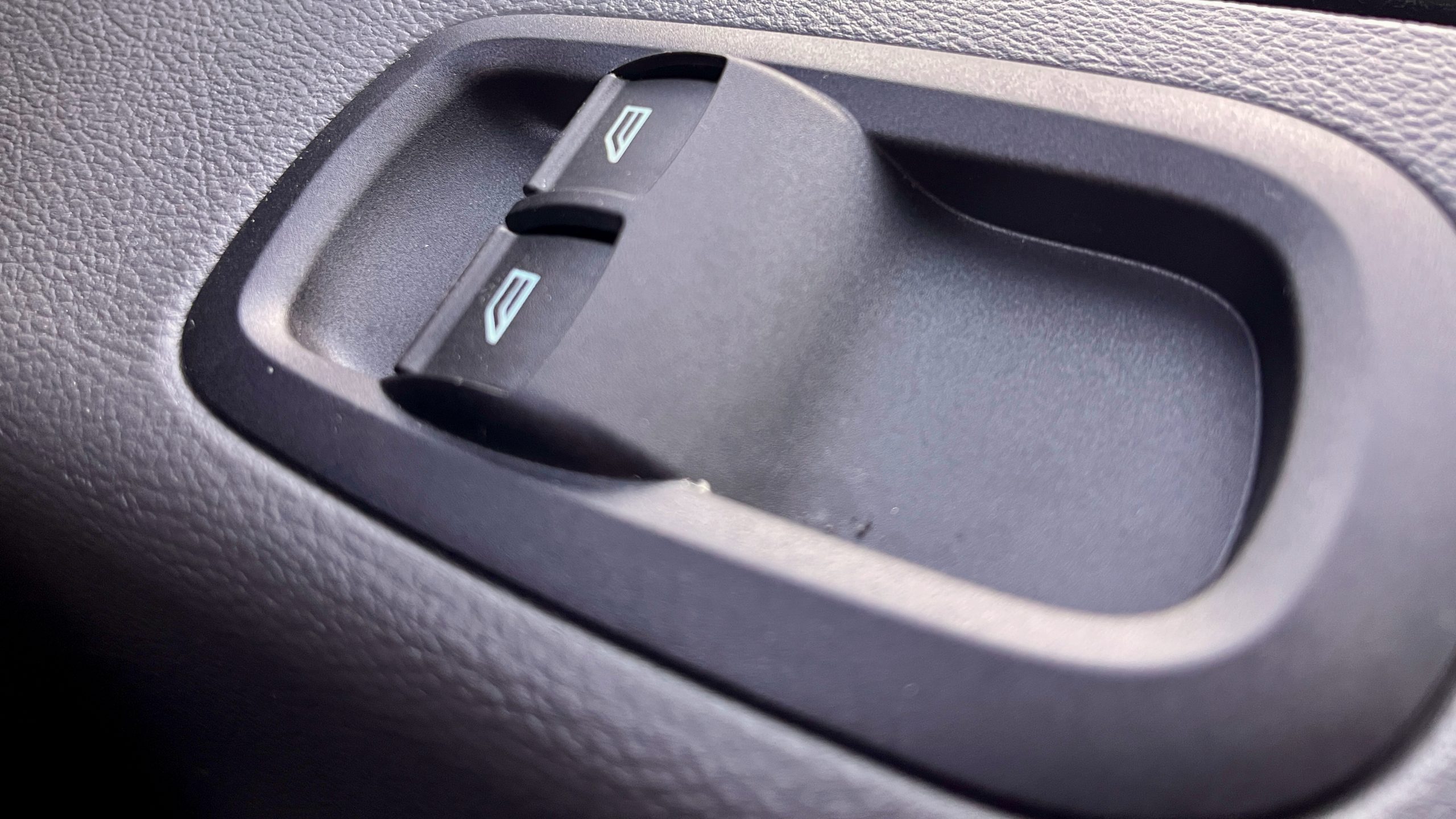
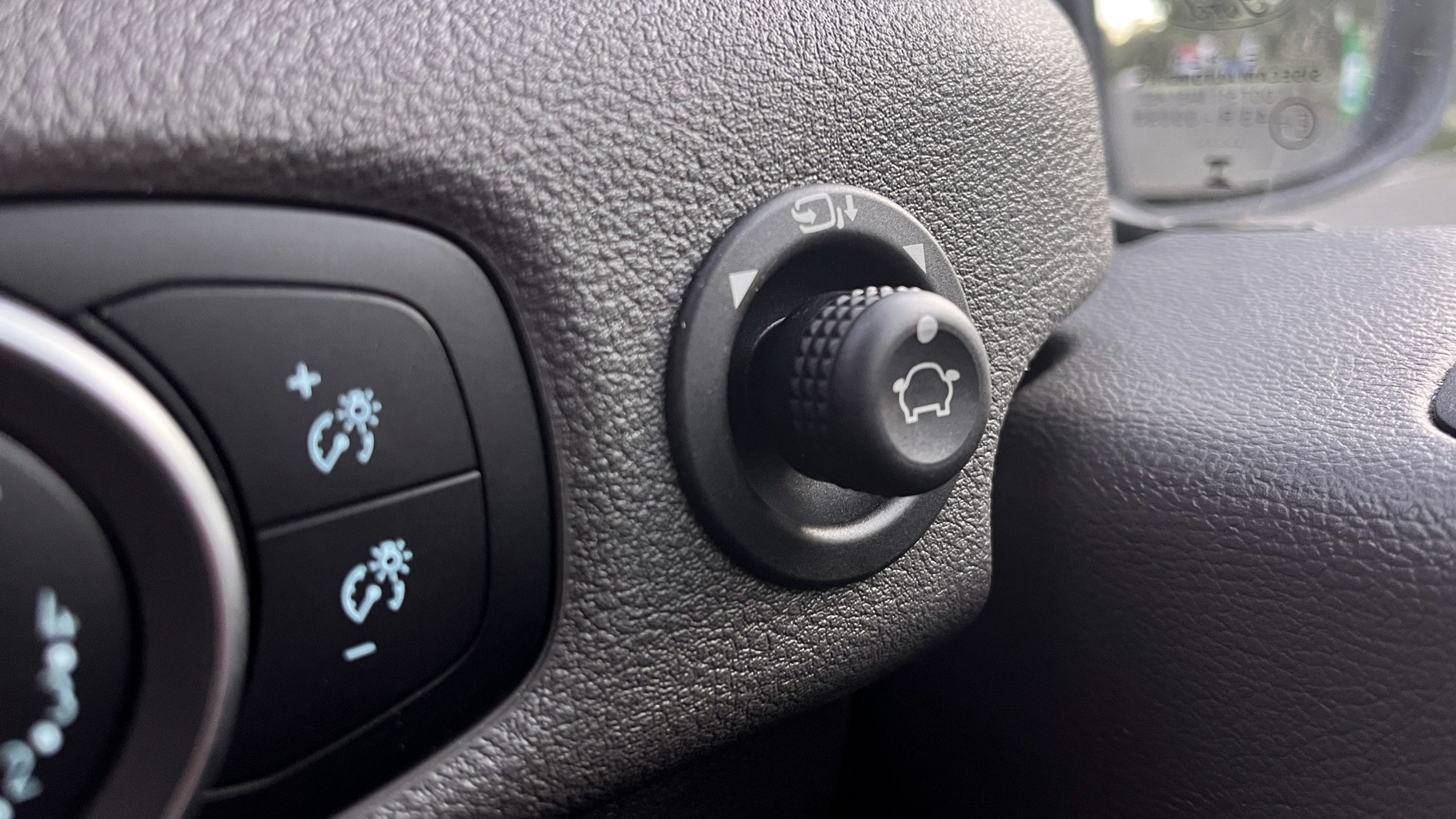
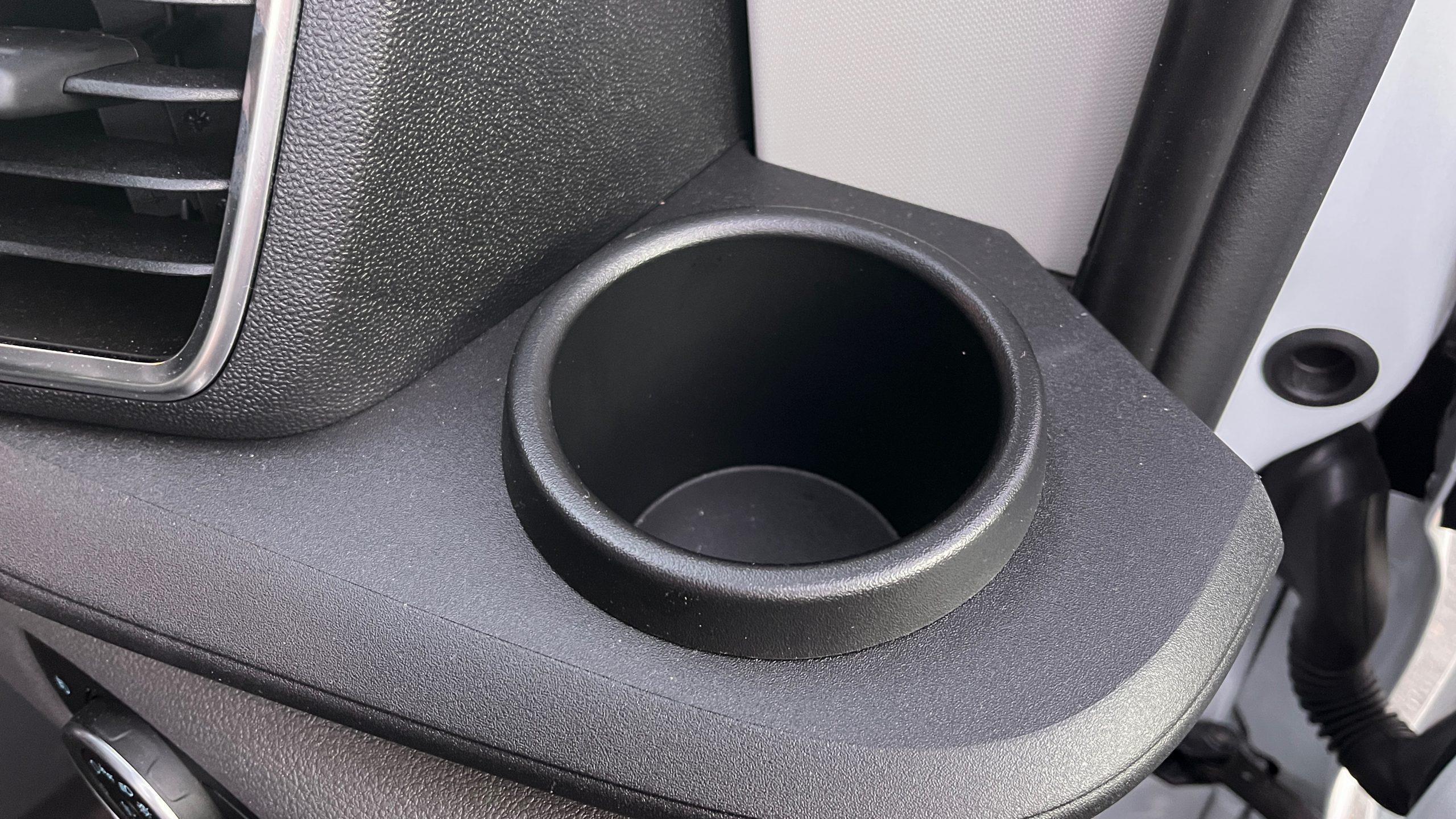
Unfortunately the bulk of the climate control system is controlled through the infotainment system, with very few physical controls, not particularly safe for van which will spend a lot of time on the road. Simply switching the system to recirculating mode requires digging through menus. That being said, we did appreciate the physical volume knob. The rear camera quality is crisp and clean, though the angle of the camera, resulting from the top mounting which can take a bit of getting used to, but ultimately helps with rear visibility.
Separating the cargo area from the front occupants is a divider that insulates occupants from the noise of the rear, and gives the E-Transit a more car like experience. It also protects the driver and passengers from the impact of cargo during a sudden stop. There is a small window to observe the cargo area, but the rear doors and the divider make rearward visibility quite limited. That being said, front visibility is excellent with the large windscreen and side windows. The oversized side mirrors are excellent and make the E-Transit seem a lot smaller than it really is.
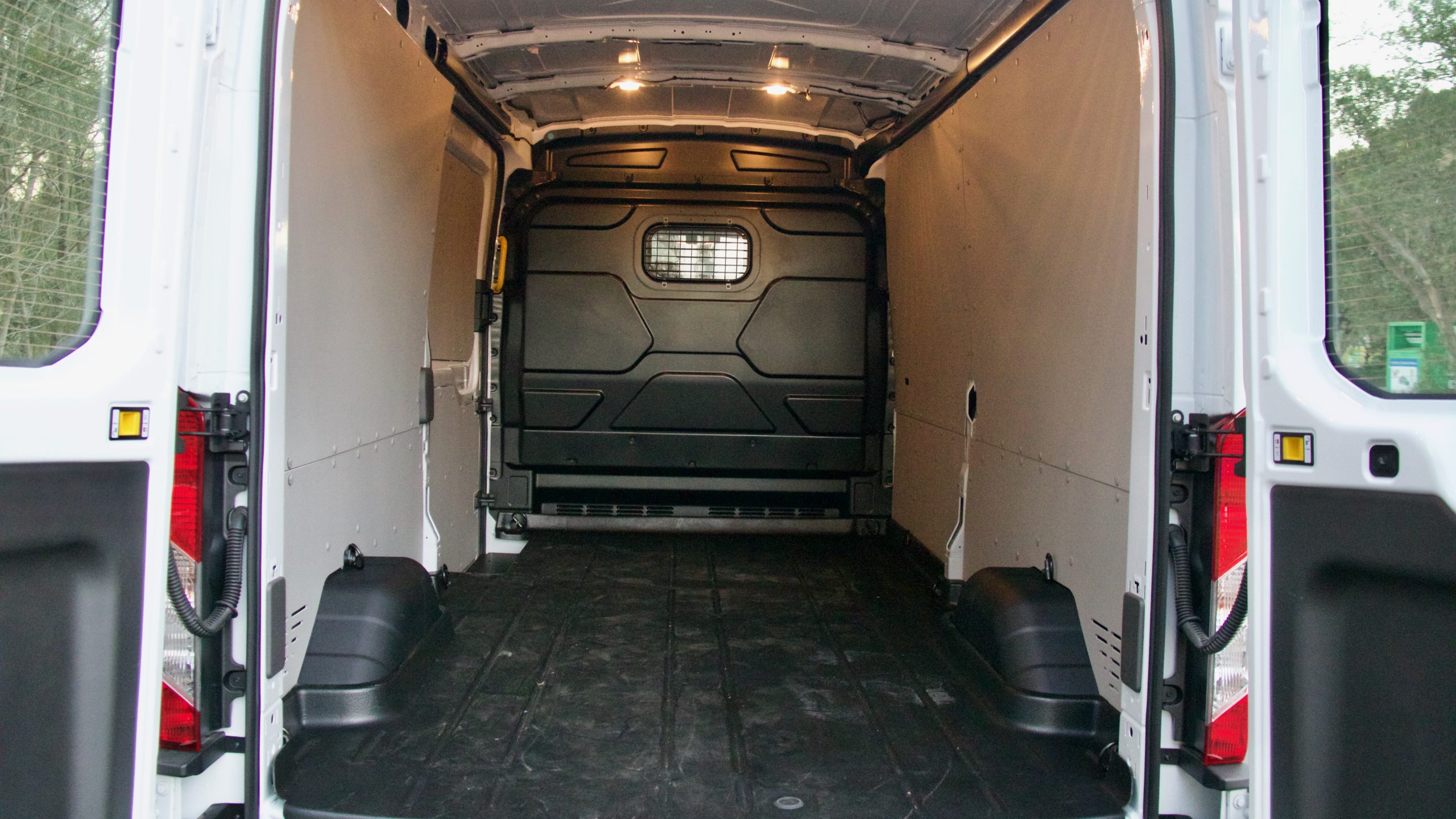
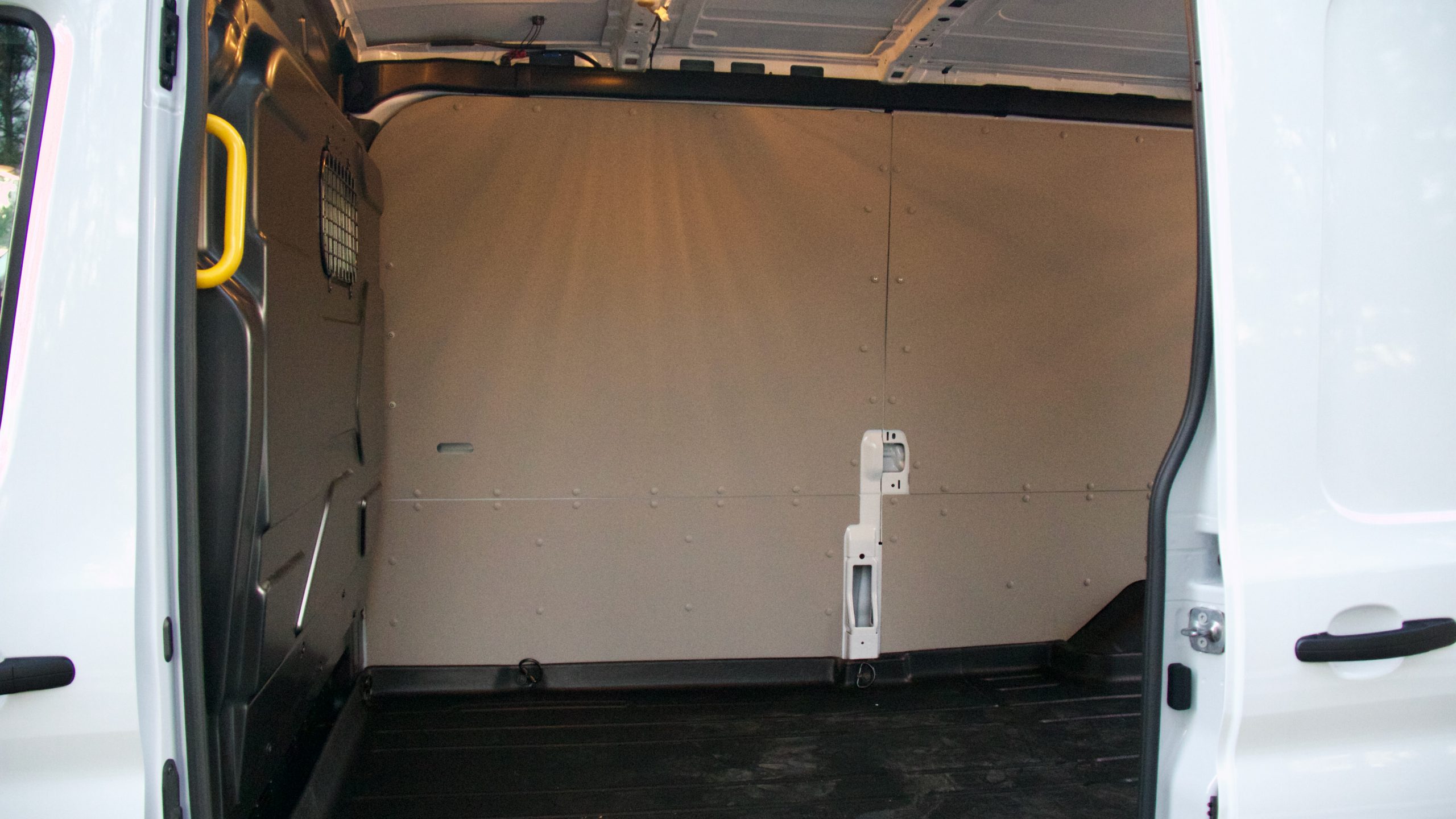
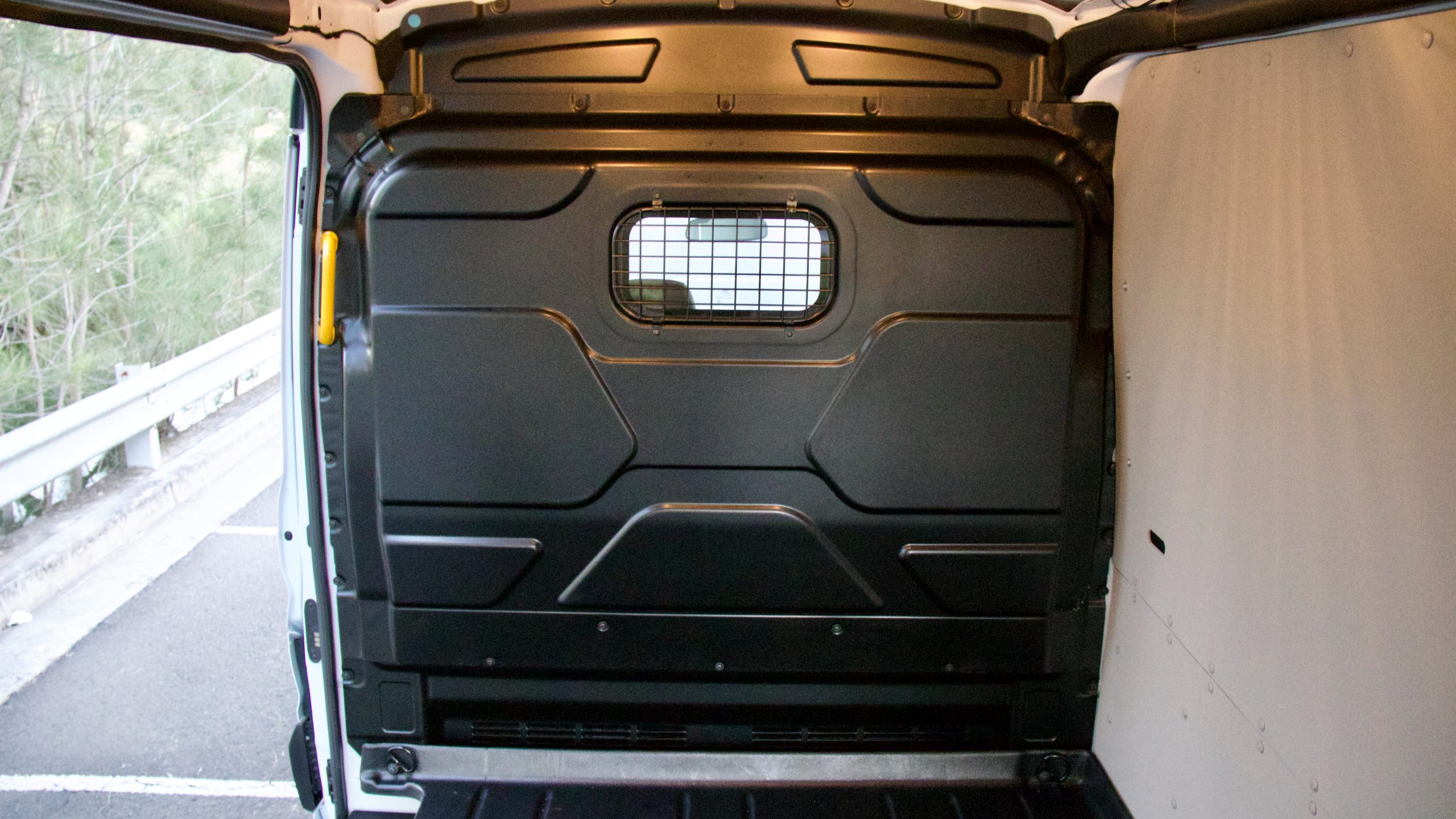
Side access to the cargo area is through a single sliding door on the left hand side, though dual-sliding doors is an option. The rear barn-style doors make it easy to load cargo into the E-Transit. At the flick of a switch located in each rear door, the doors swing around 270-degrees and magnetically lock onto the side of the van, keeping them out of the way and making loading the rear easier.
11-cubic metres of cargo space is on offer in the mid-roof variant of the E-Transit and 12.4-cubic metres in the the high-roof variant we tested. The payload for the mid-roof van is 1,611kg and for the high-roof it is 1,566kg. All Ford E-Transits have a 4.25-tonne GVM (Gross Vehicle Mass). A standard pallet will fit between the rear wheel arches in the cargo area of this large van. The cargo area features both tie down hooks and a 12-volt power outlet.
Service & Warranty: 9/10
The 2023 Ford E-Transit Van comes with the five-year/unlimited kilometre warranty offered across the Ford range, though it is worth noting that the battery pack in the E-Transit is warranted for eight-years or 160,000km whichever comes first. It also comes with 12-months of roadside assistance that is extended by 12-months at every scheduled service at a Ford dealer for up to seven-years. The LDV eDeliver 9, by comparison, comes with a lesser five-year/160,000km warranty, but with an identical eight years/160,000km warranty for the battery pack. The LDV comes with a five-year/160,000km roadside assist program.
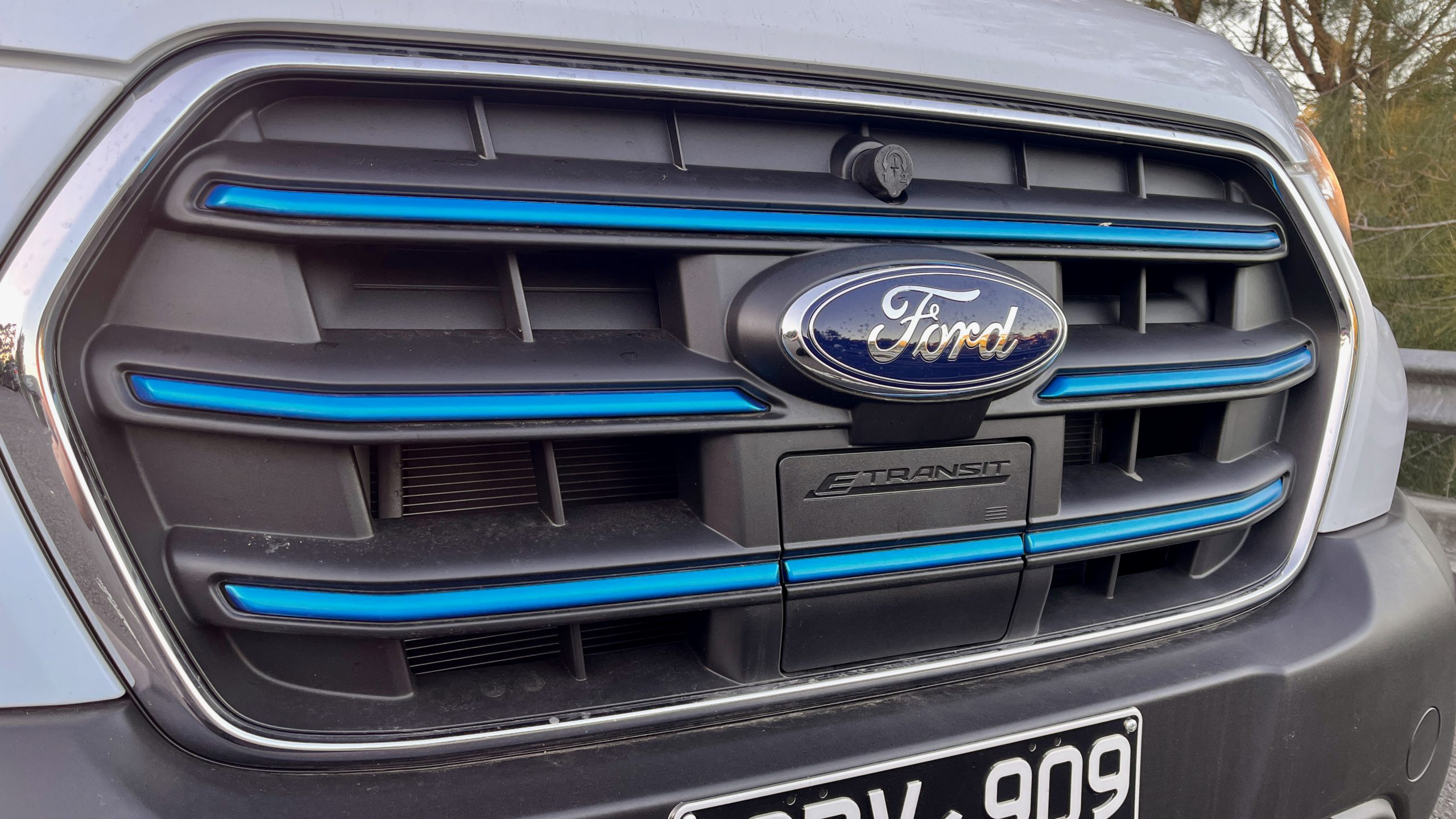
The 2023 Ford E-Transit requires servicing every 12-months or 30,000km. Servicing the E-Transit over the span of five-years or 150,000km will set owners back a very reasonable $925 (services are $185 a pop). LDV does not quote service pricing for the eDeliver9.
2023 Ford E-Transit Van DiscoverAuto Rating: 8.1/10
With the E-Transit, Ford has delivered a very capable van, with a fairly modern interior, capable handling, good performance and the same practical cargo space as the rest of the normal Transit range. That being said, there are two elephants in the room – the price and the battery range. We’re not entirely convinced of the value equation of the E-Transit – while it does represent good value compared to the LDV e-Deliver 9, we’re not sure if the nearly $40,000 price jump over the standard Transit is worth it. There is also too much equipment missing that should be standard at the difficult to swallow $100,000 price point. The battery range, which even by the official quoted numbers is low, is even worse in the real world, really compromising the practicality of what is an otherwise quite practical van.
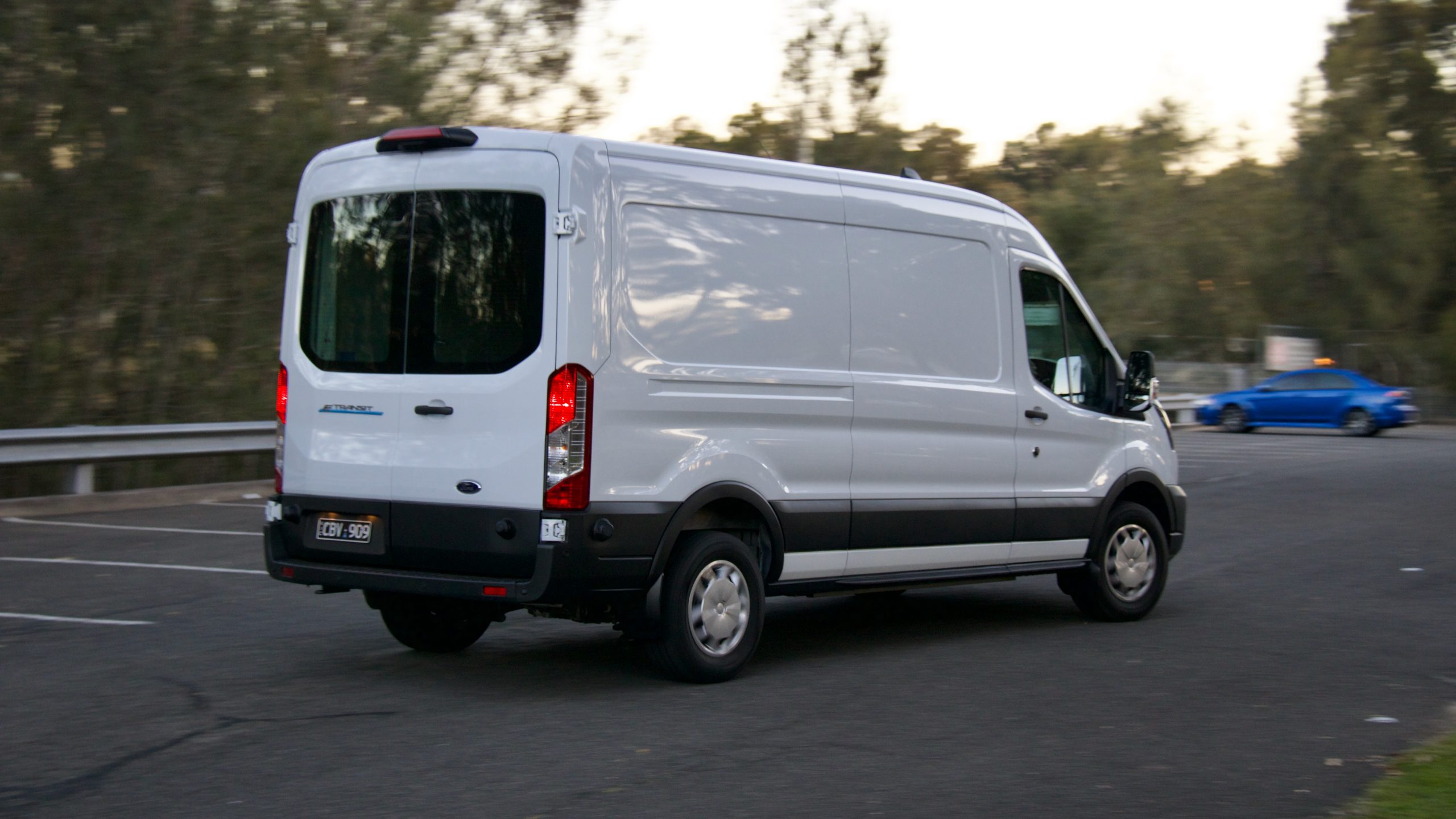
Overall we do think Ford has made a great first effort in creating a battery powered commercial van, and we look forward to seeing the future improvements that Ford can make in the area. Overall we did come away impressed from our week with the E-Transit, but faced with the choice of buying or recommending one, we’d would have a hard time justifying the $104,990 +ORC asking price.
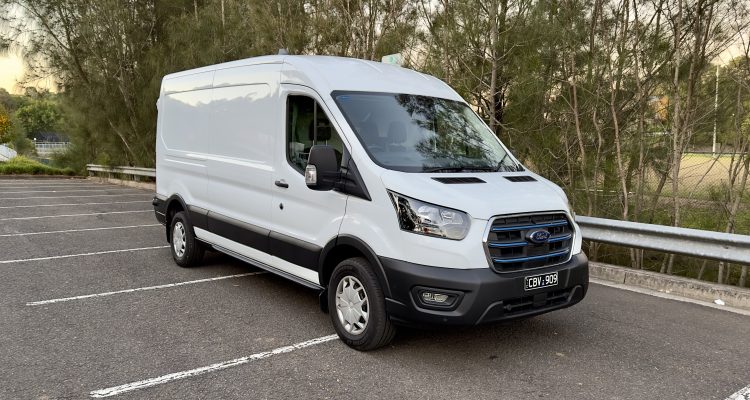
Leave a Reply